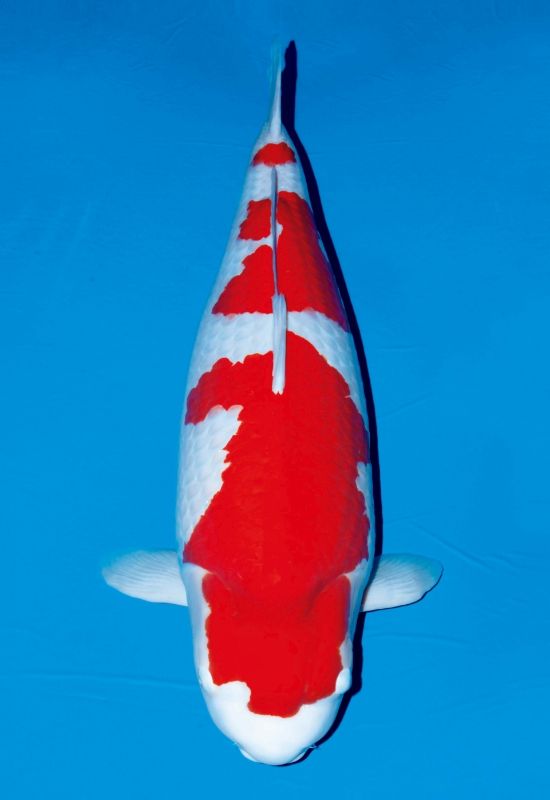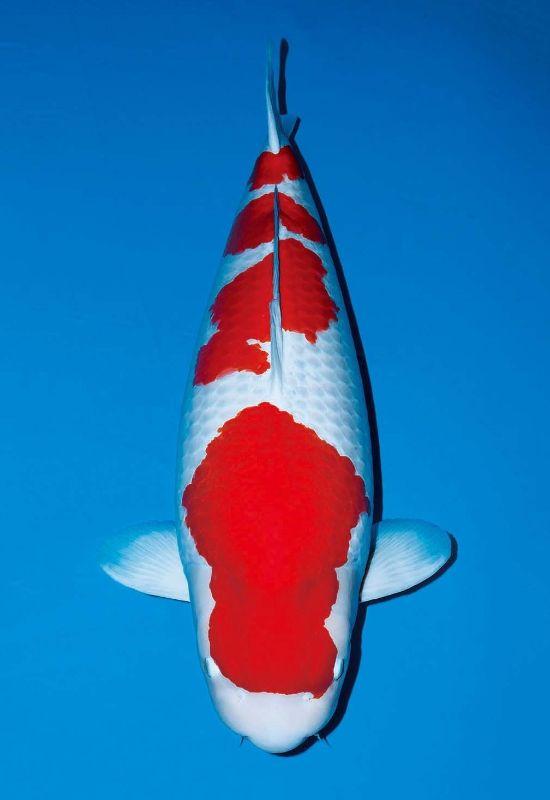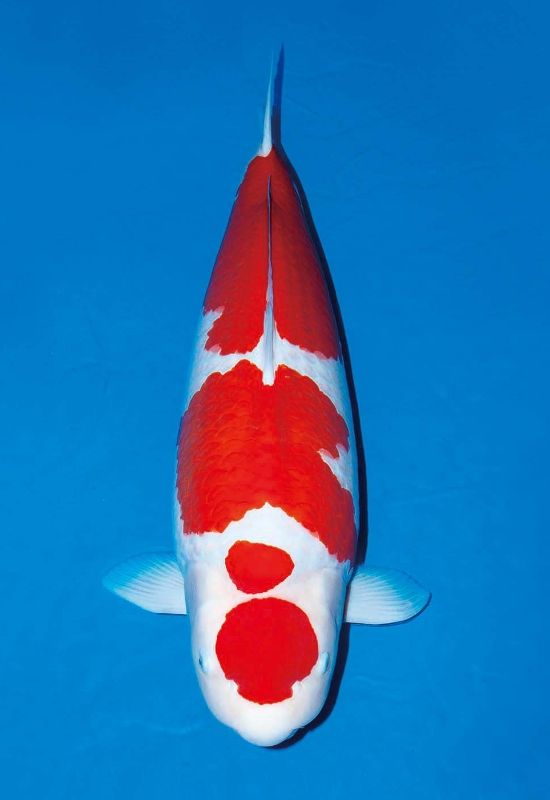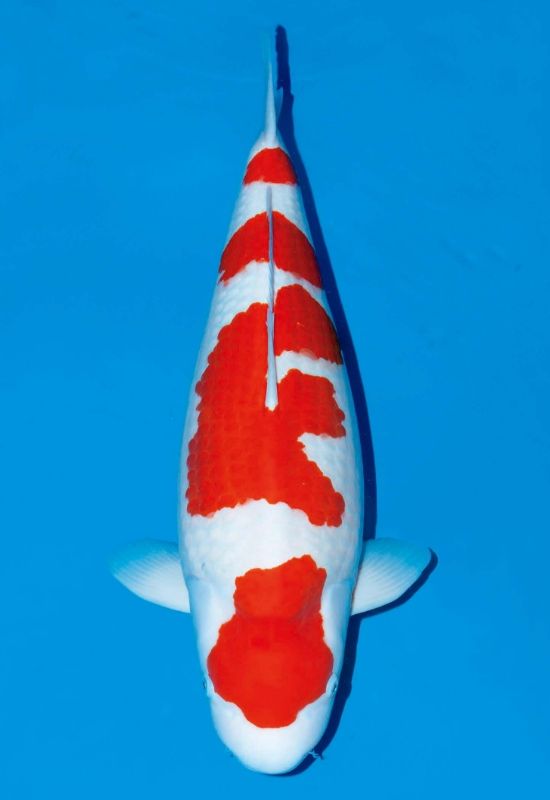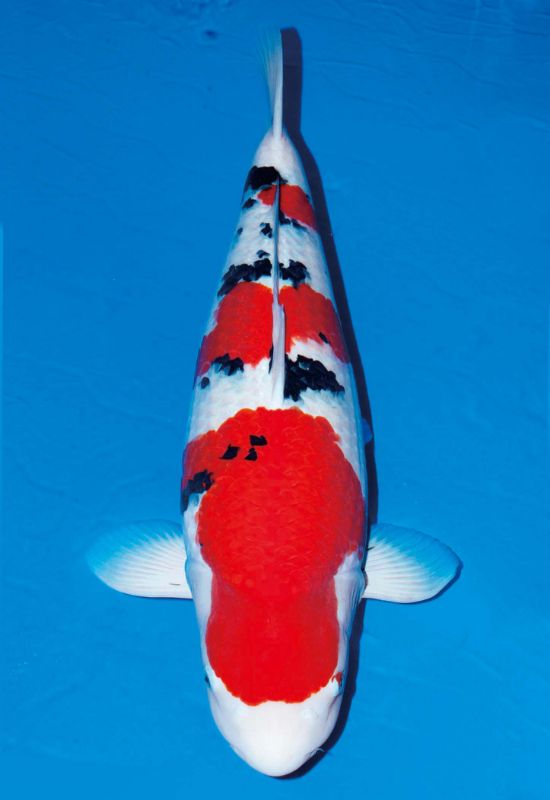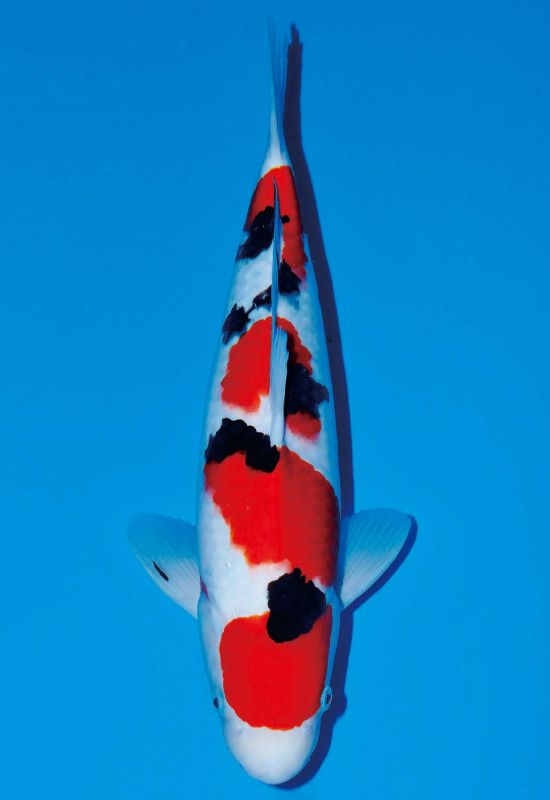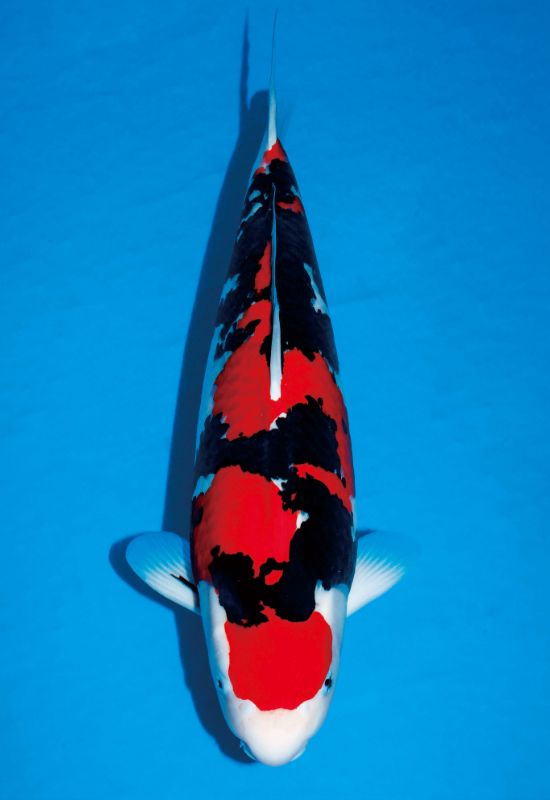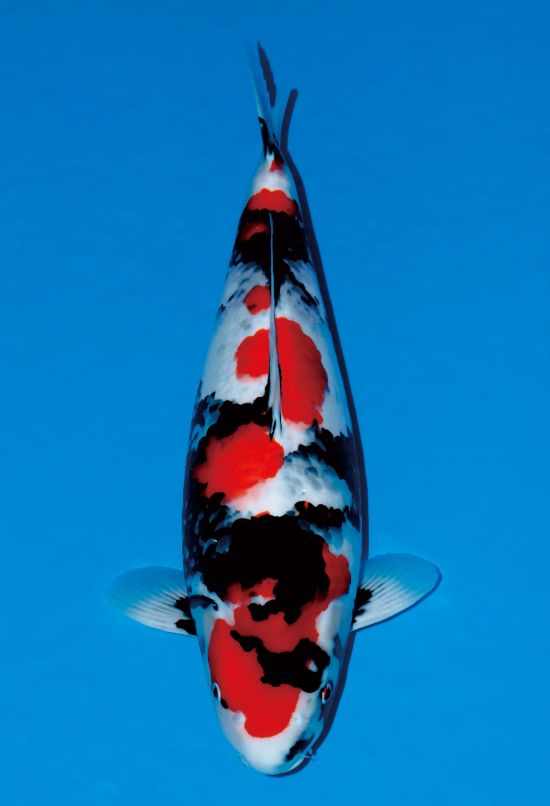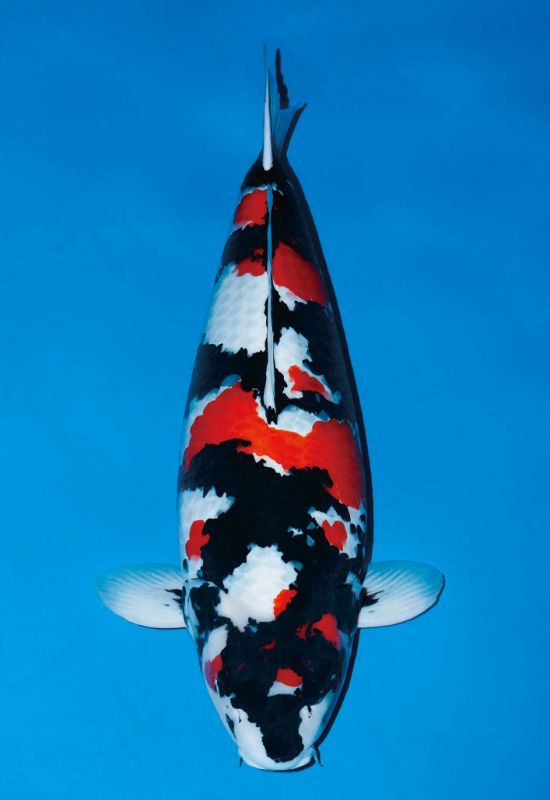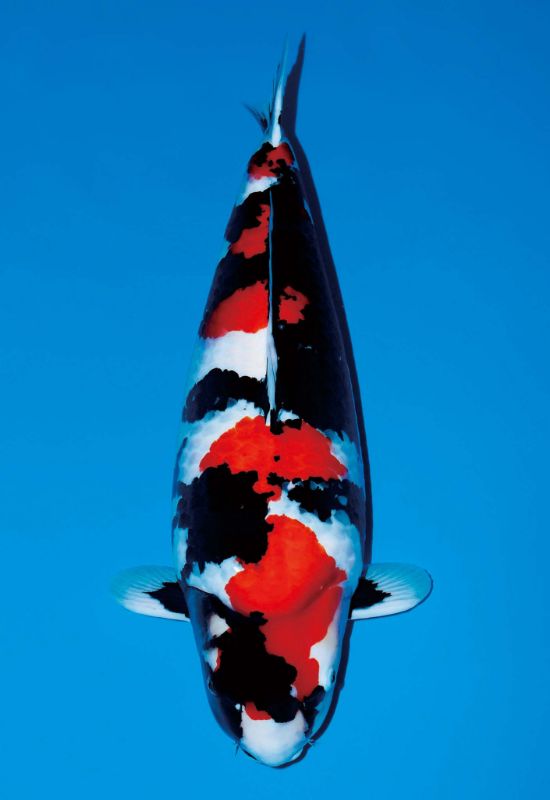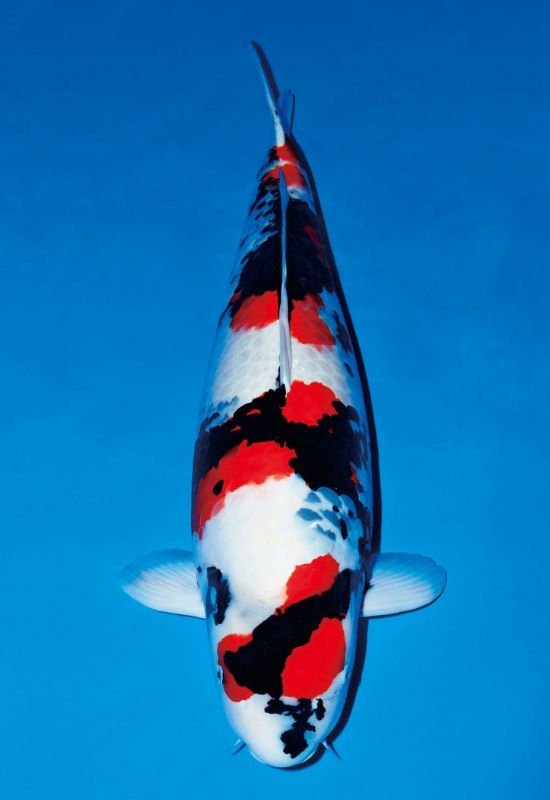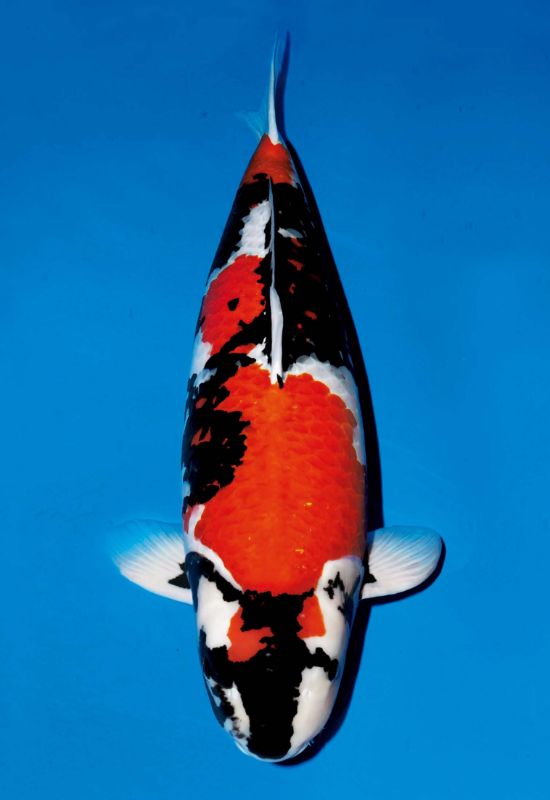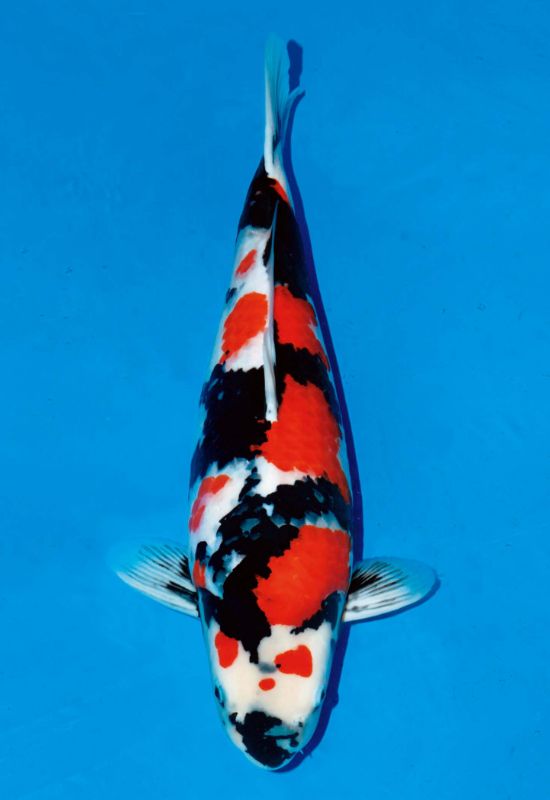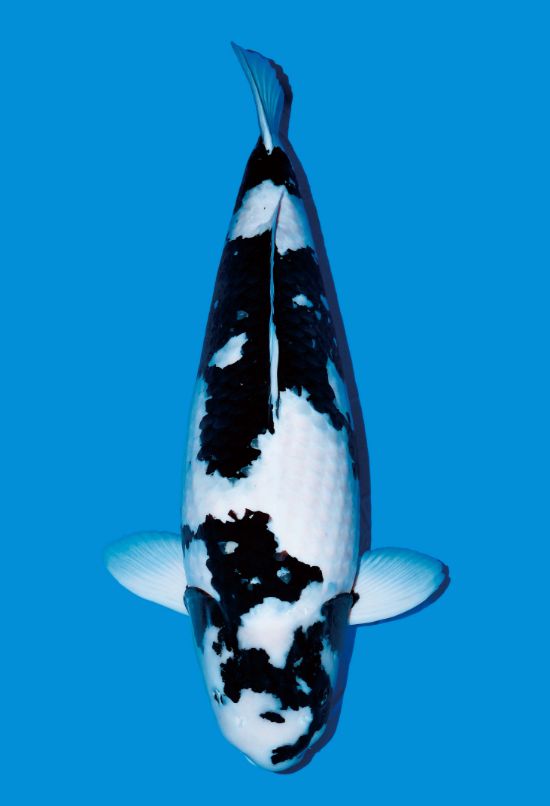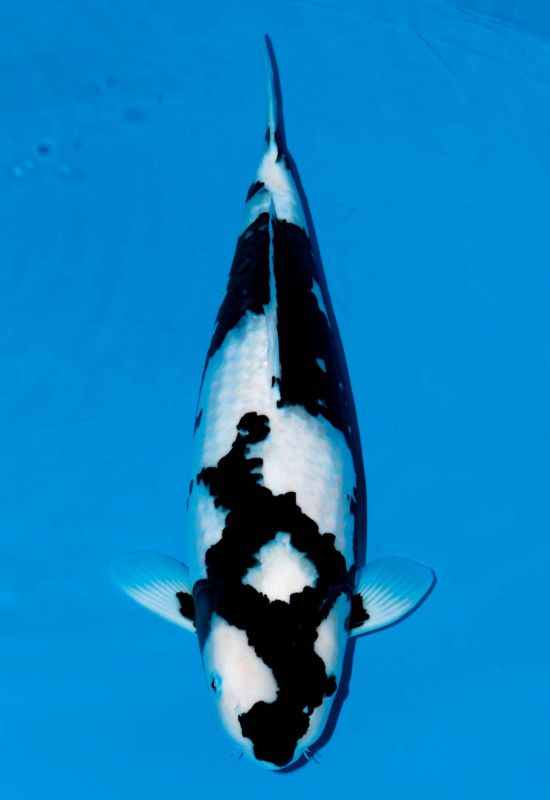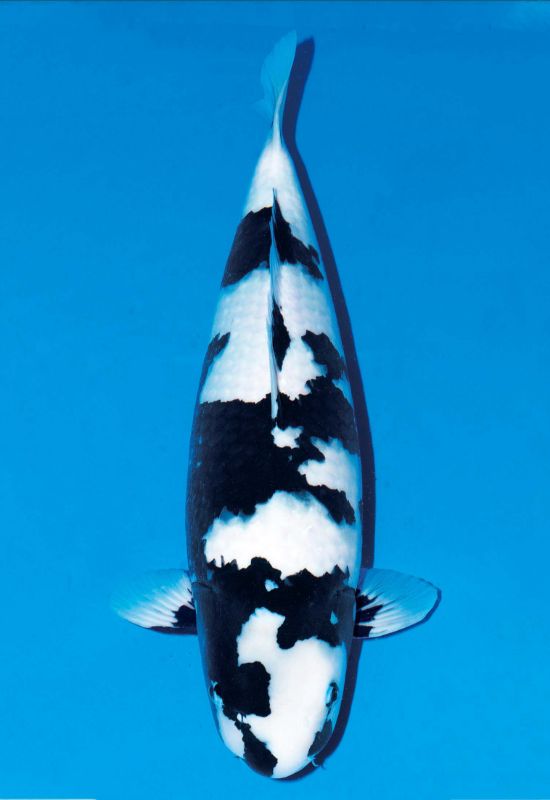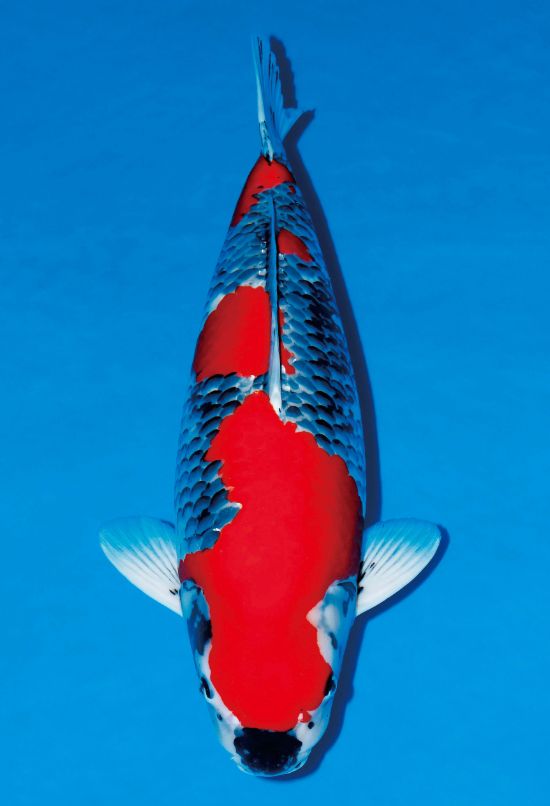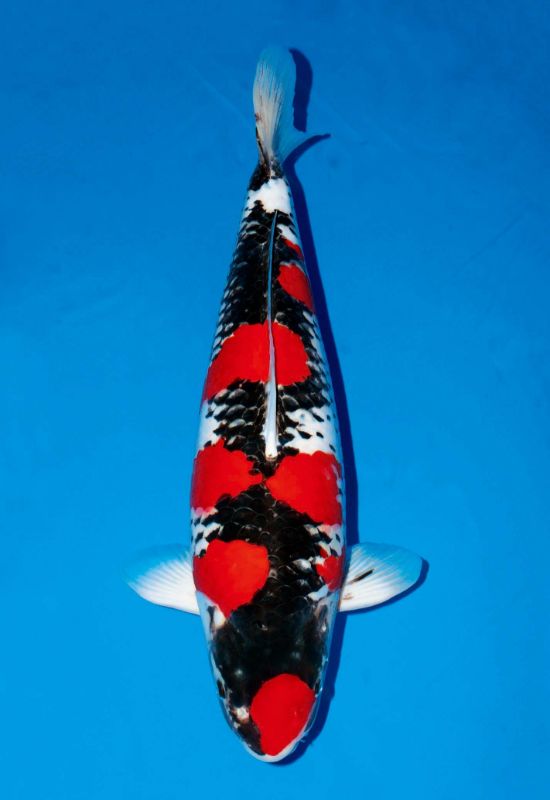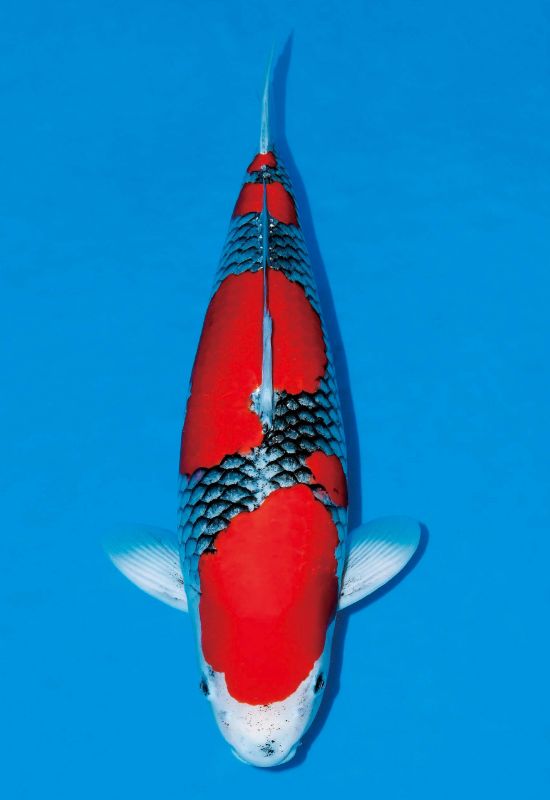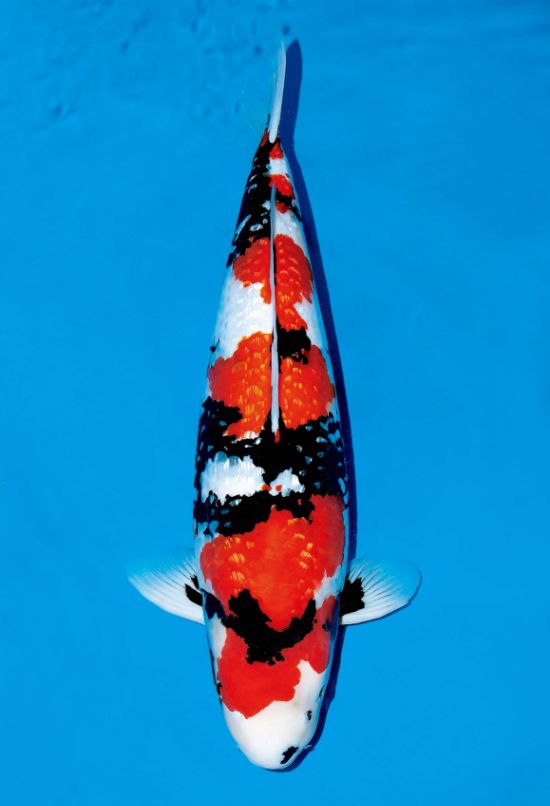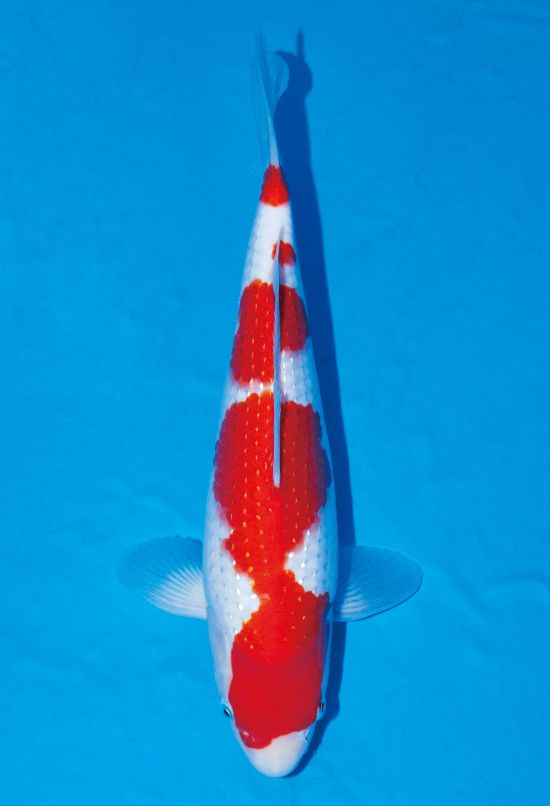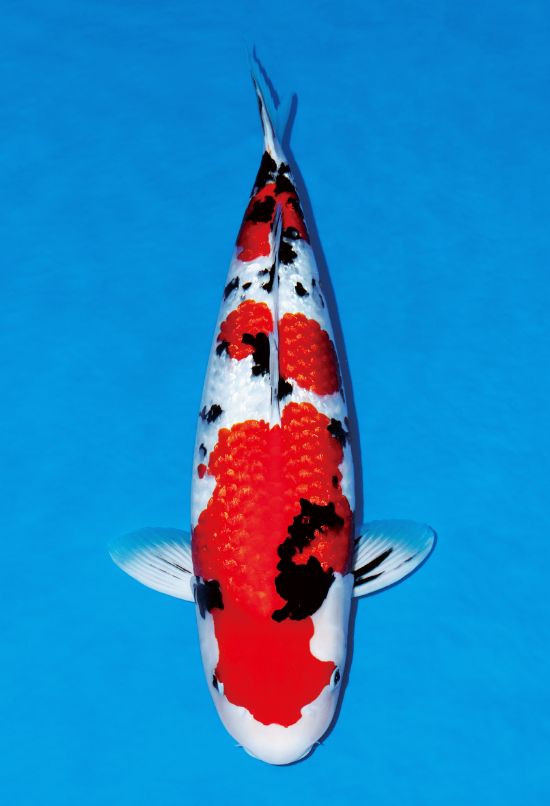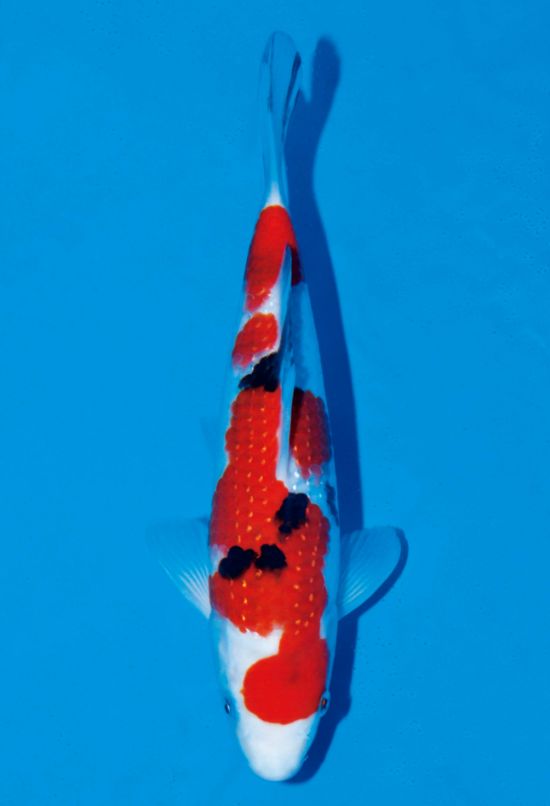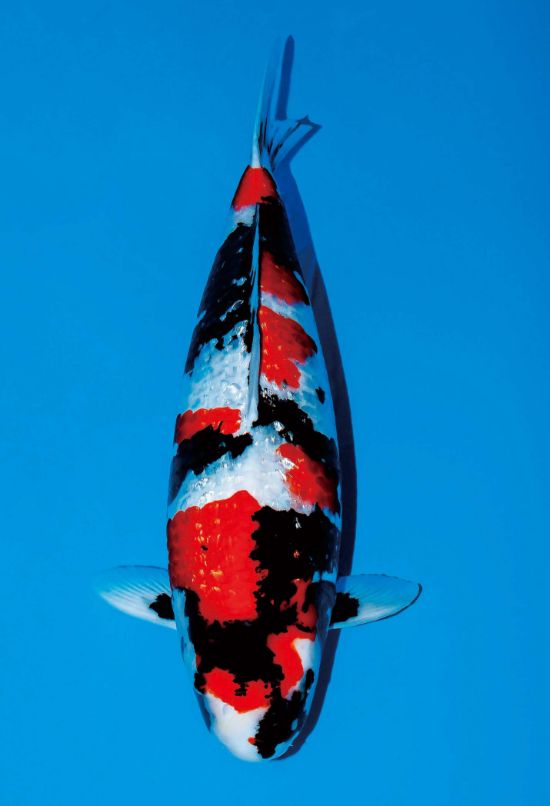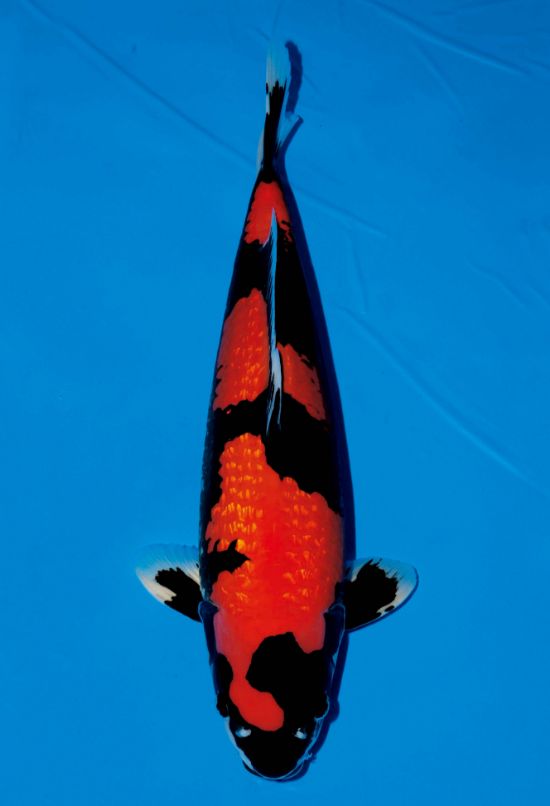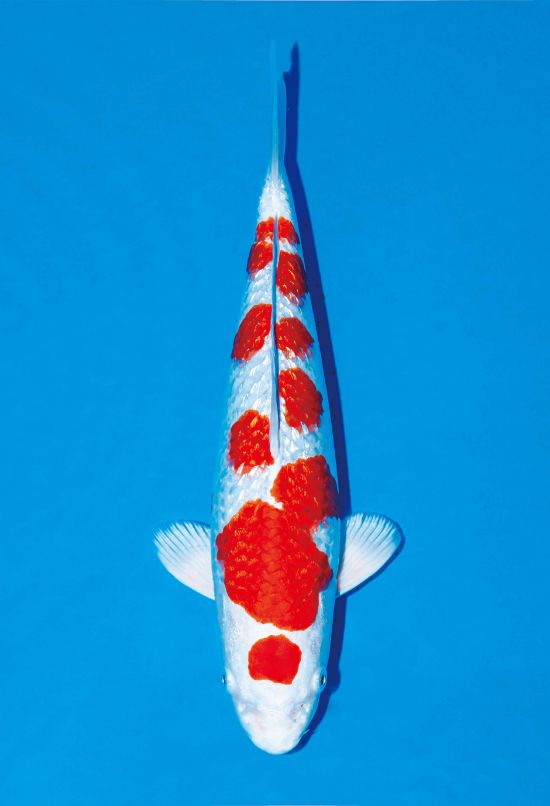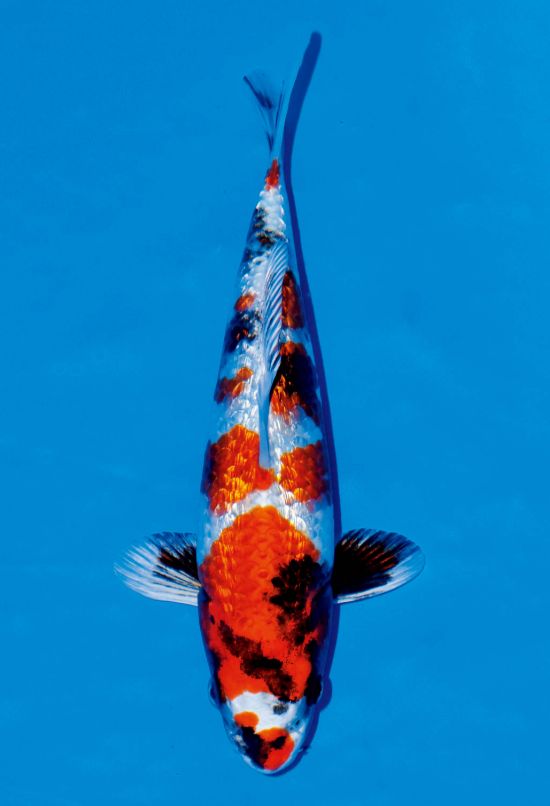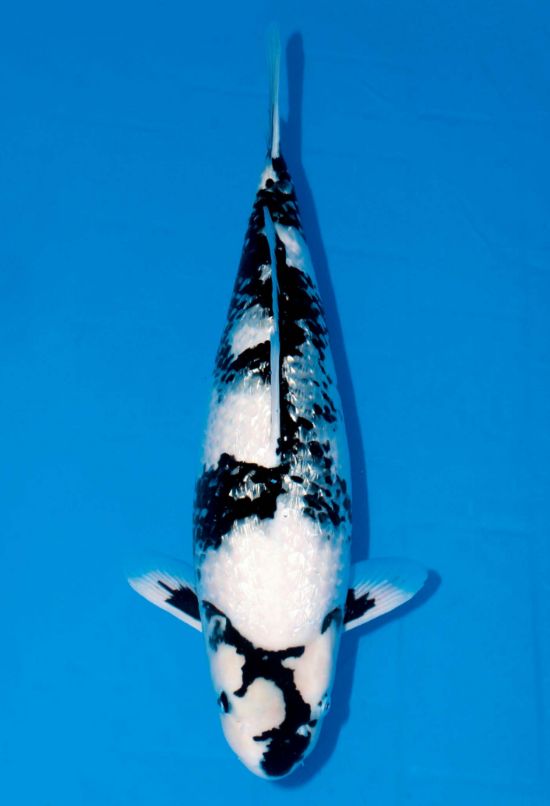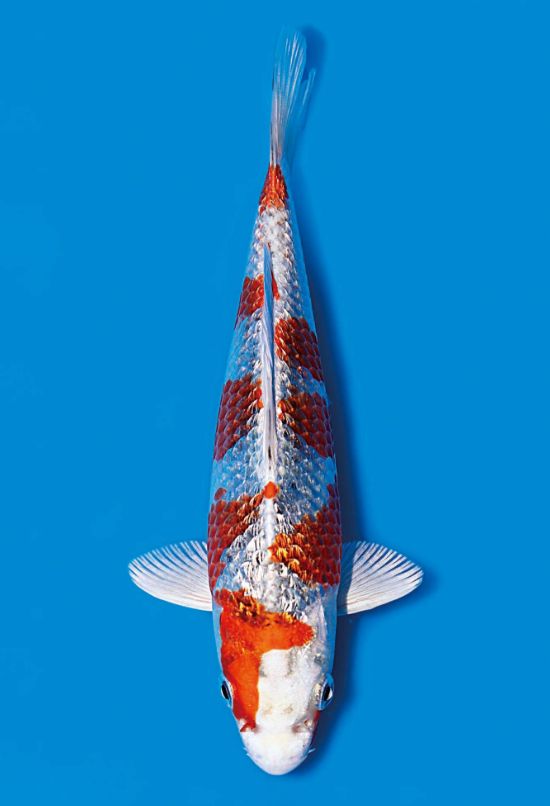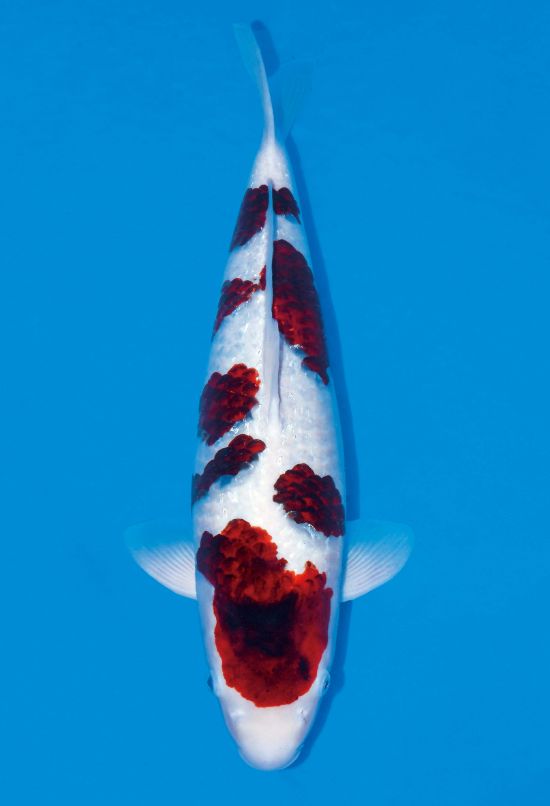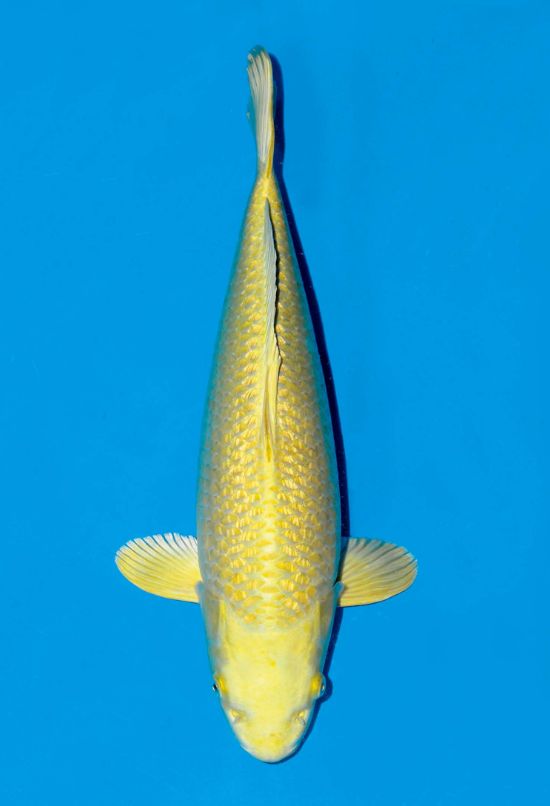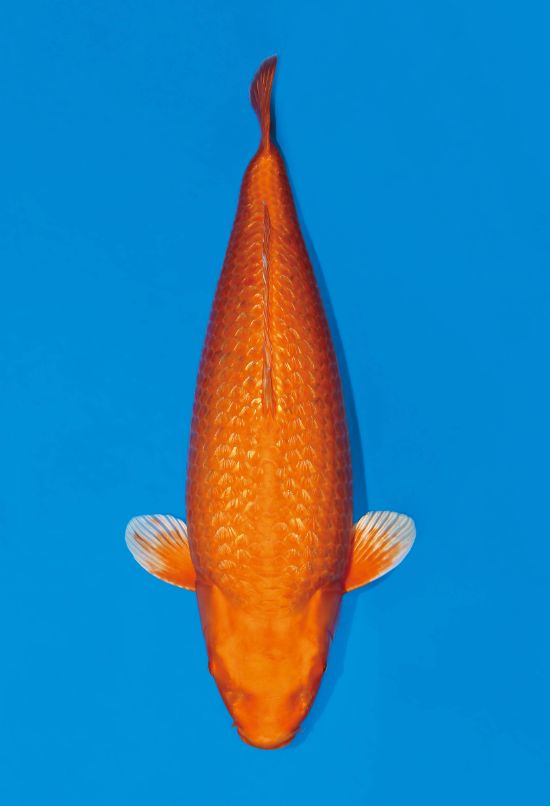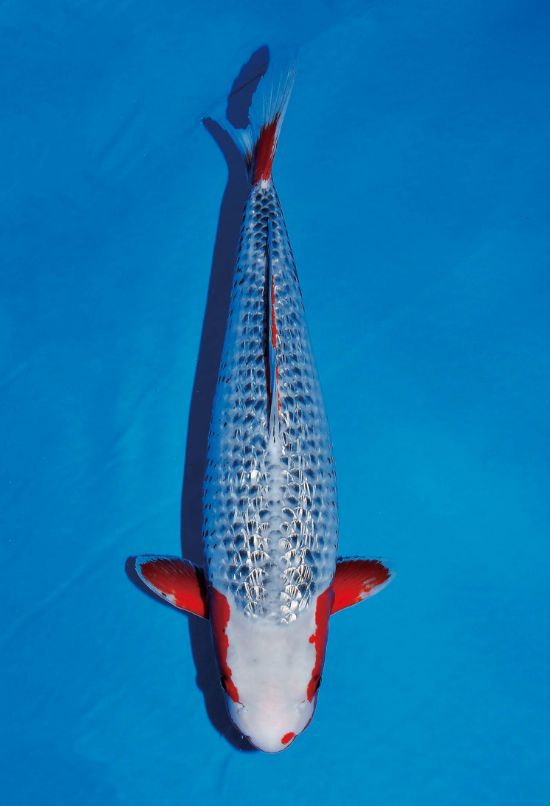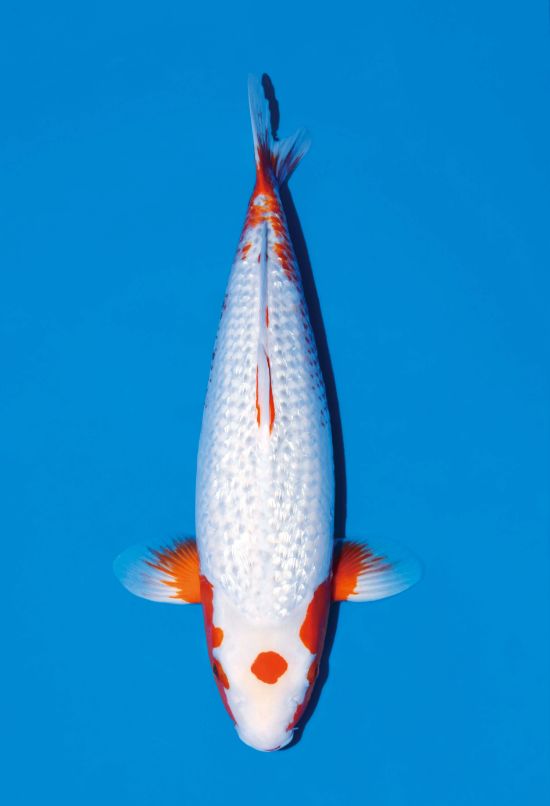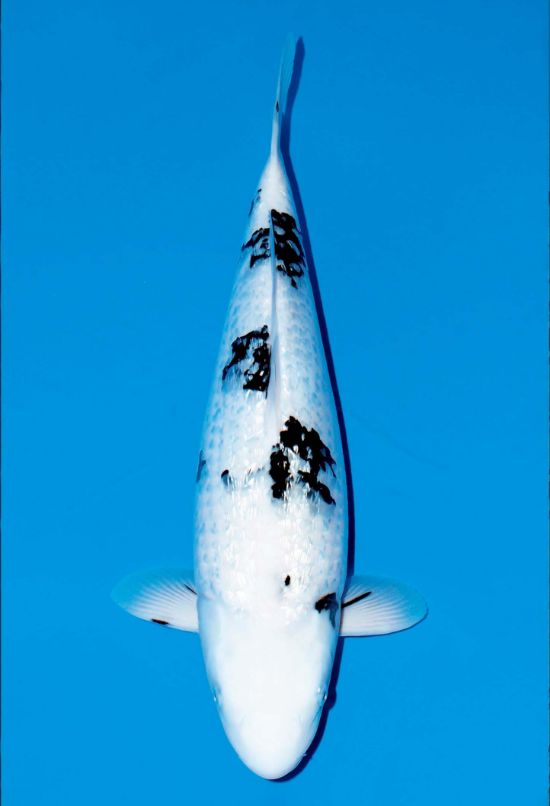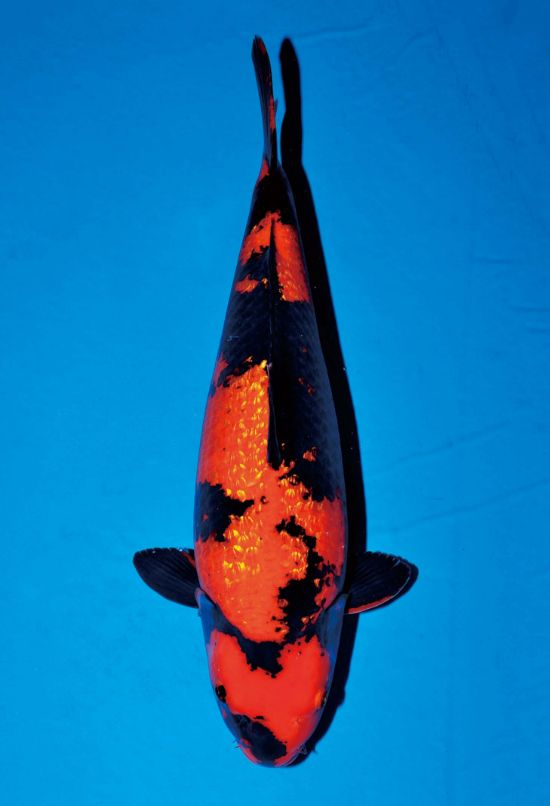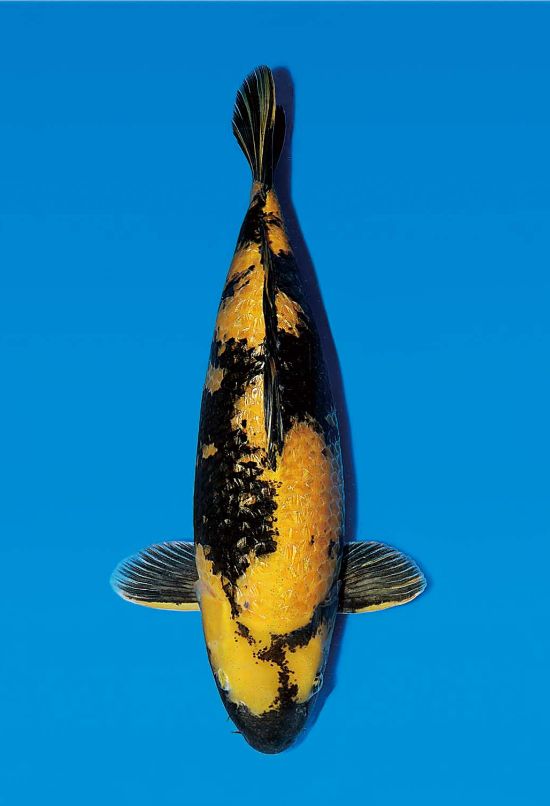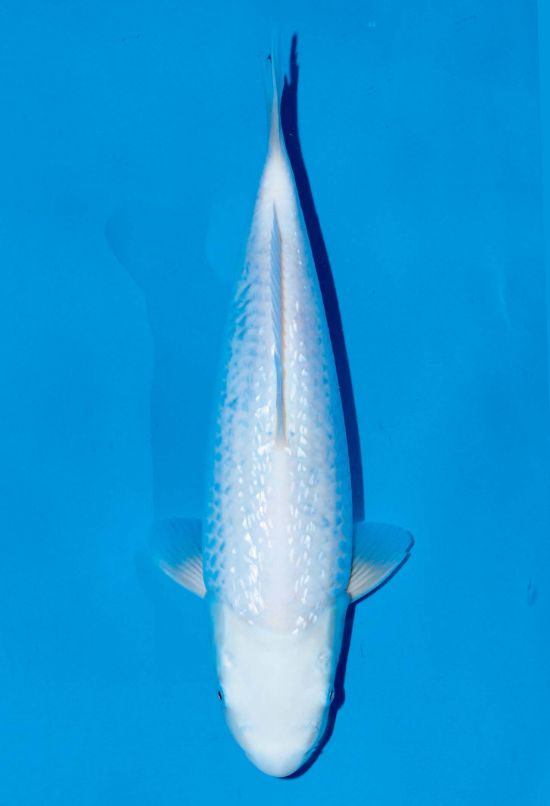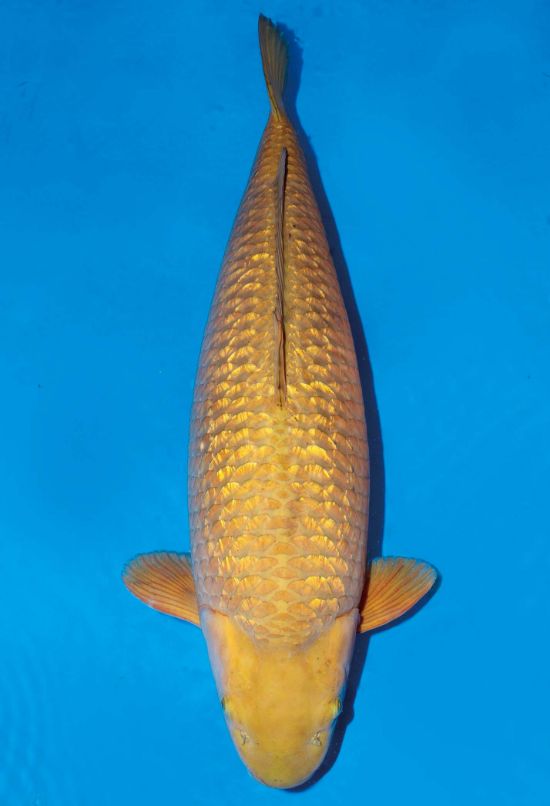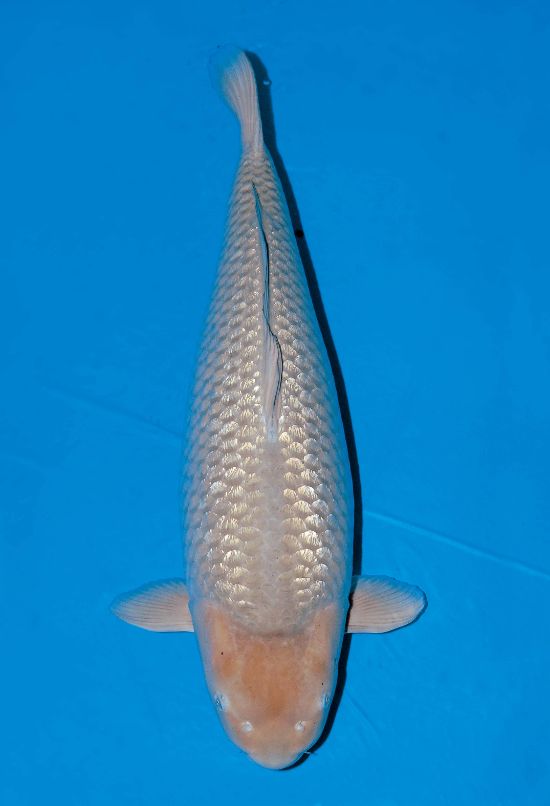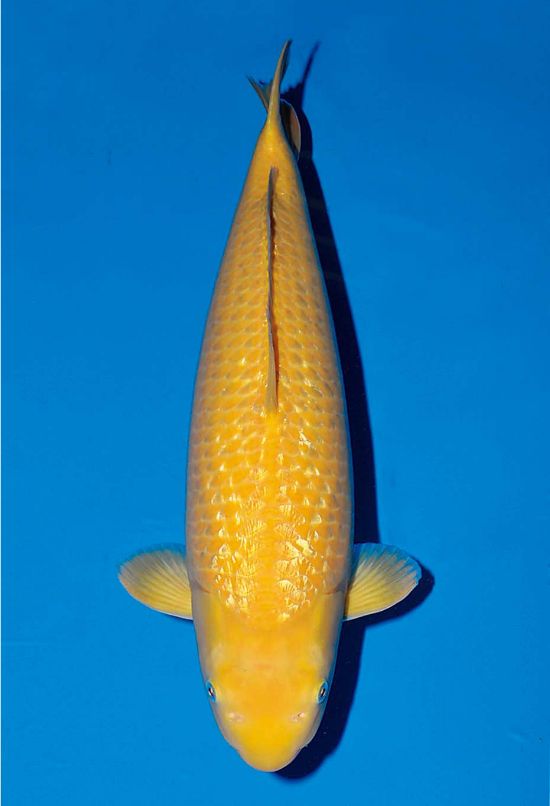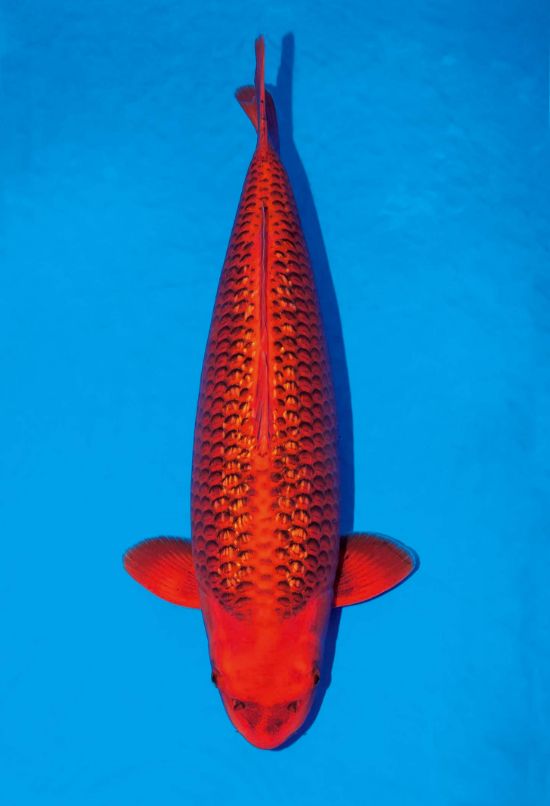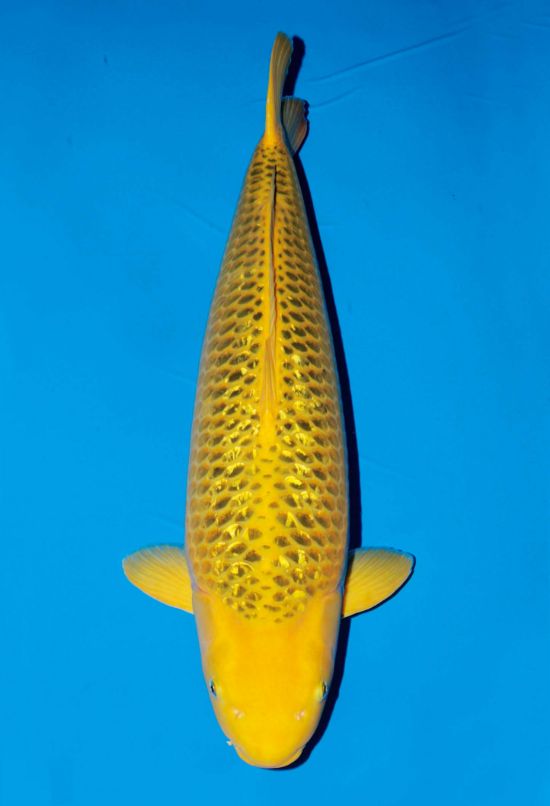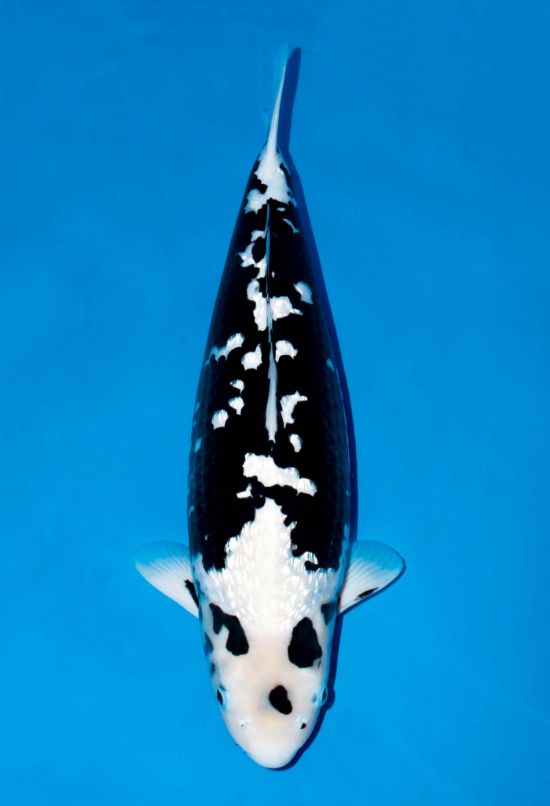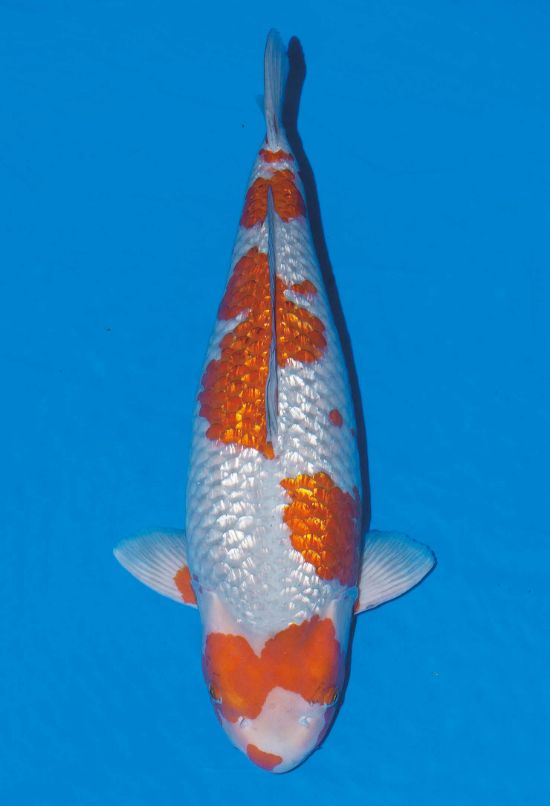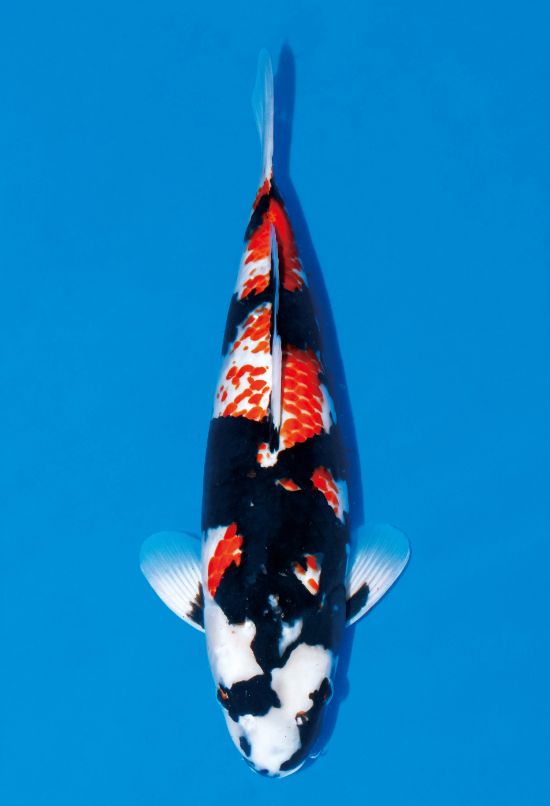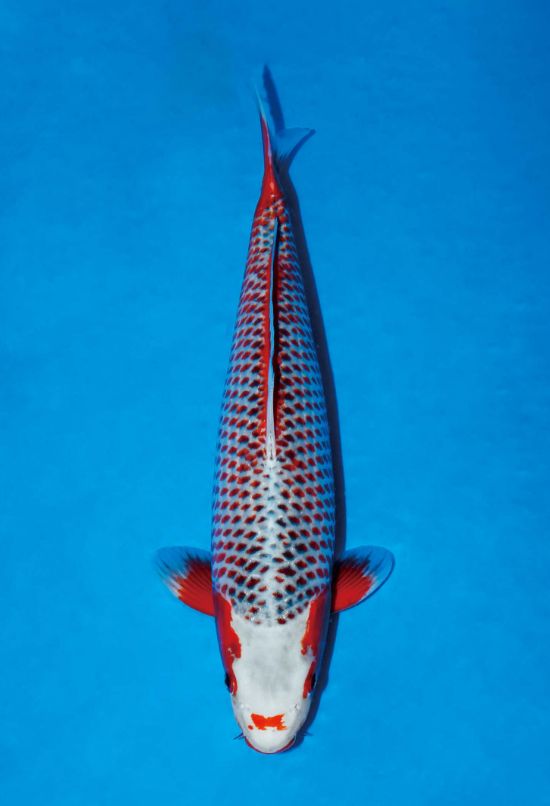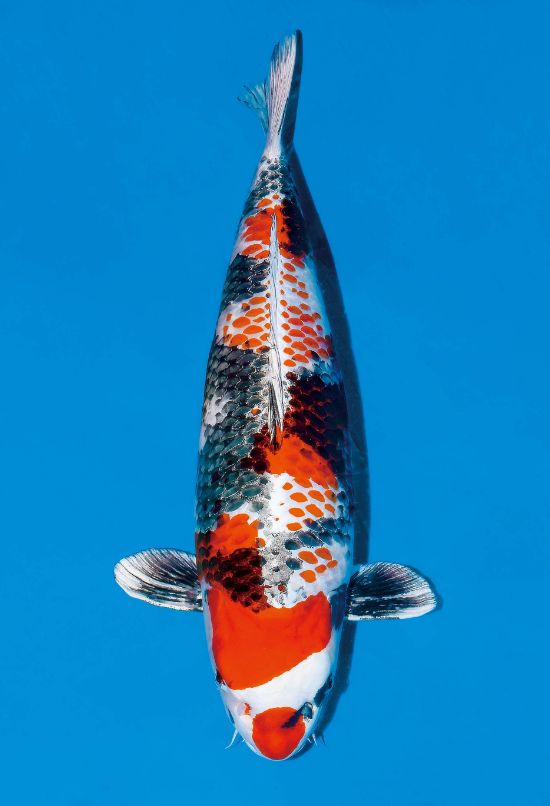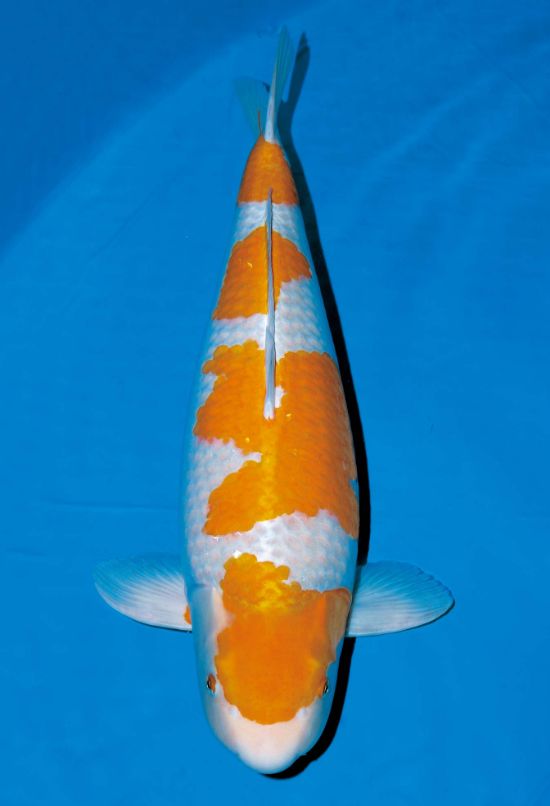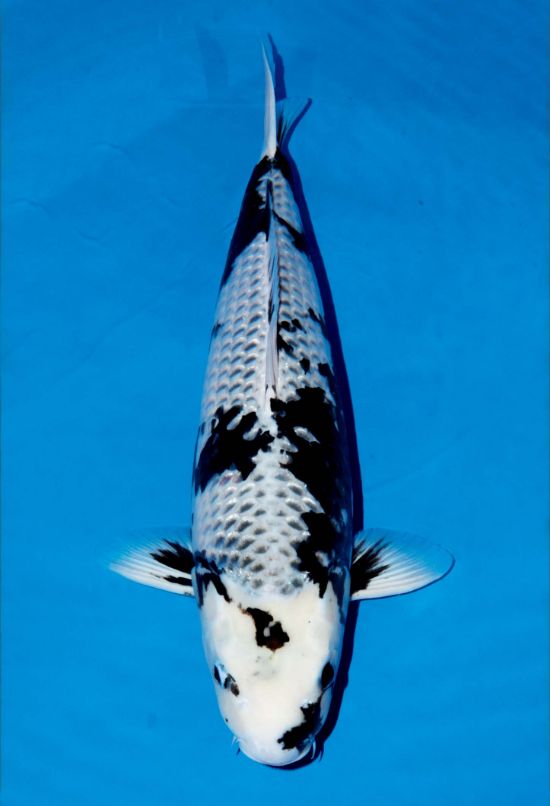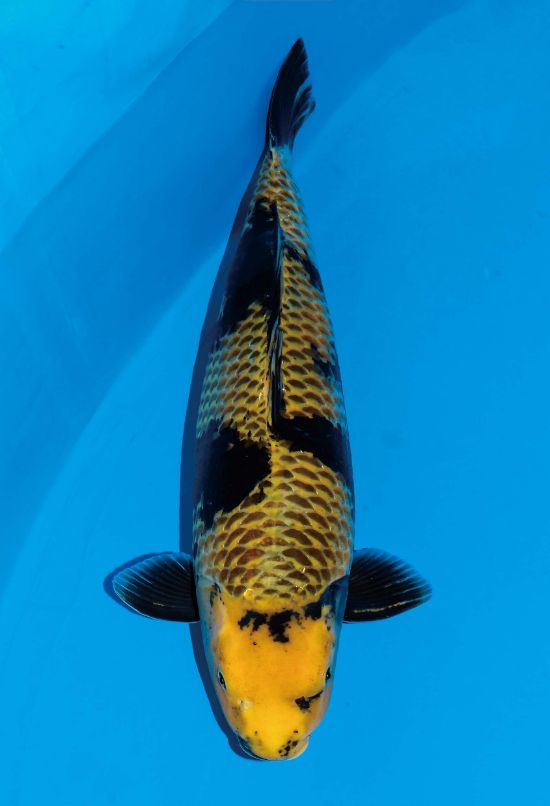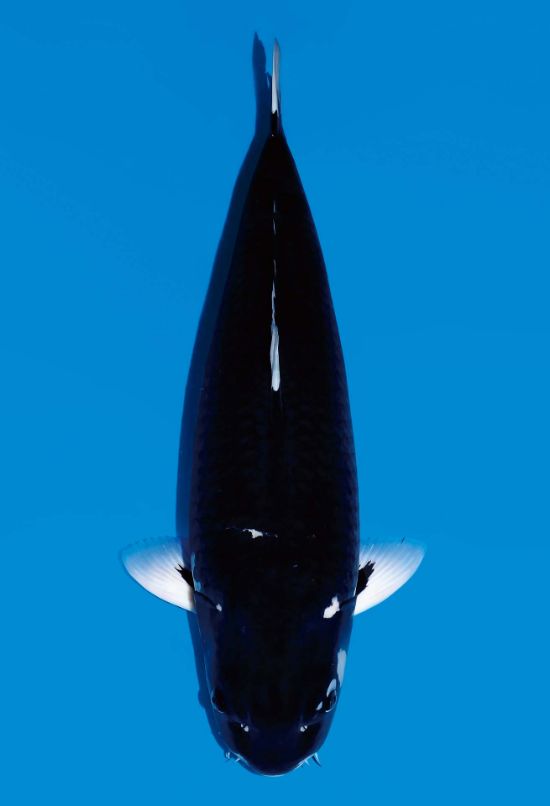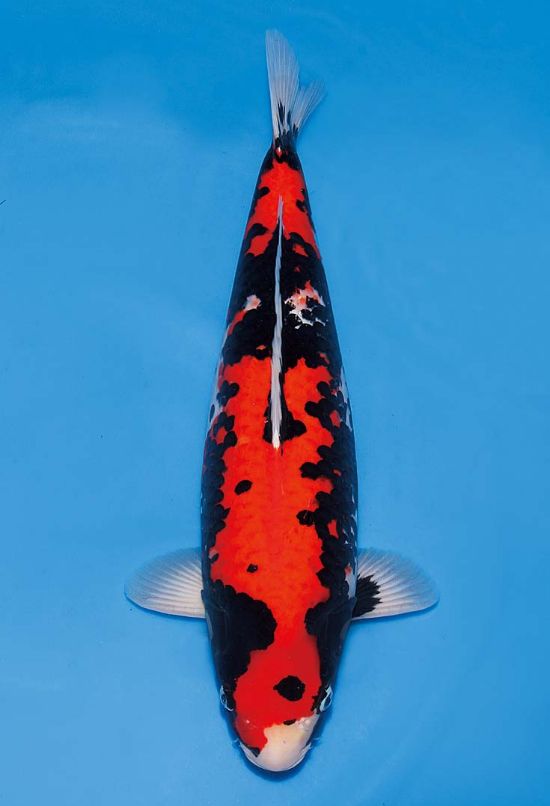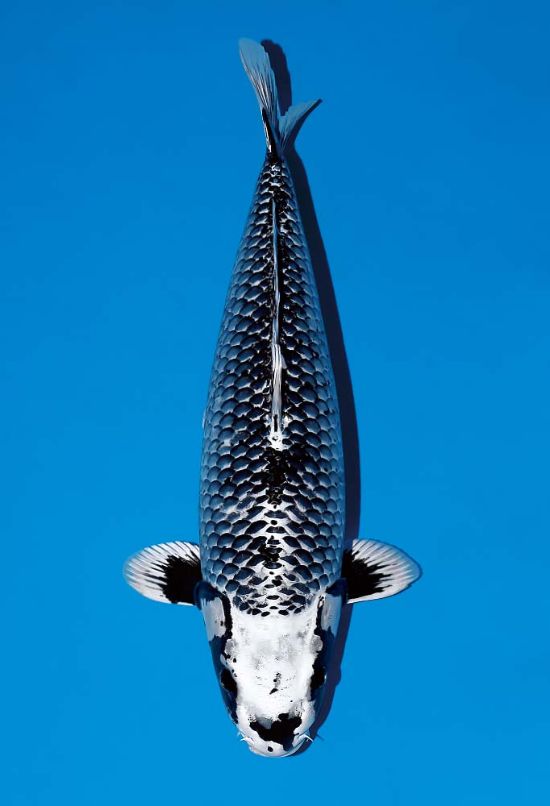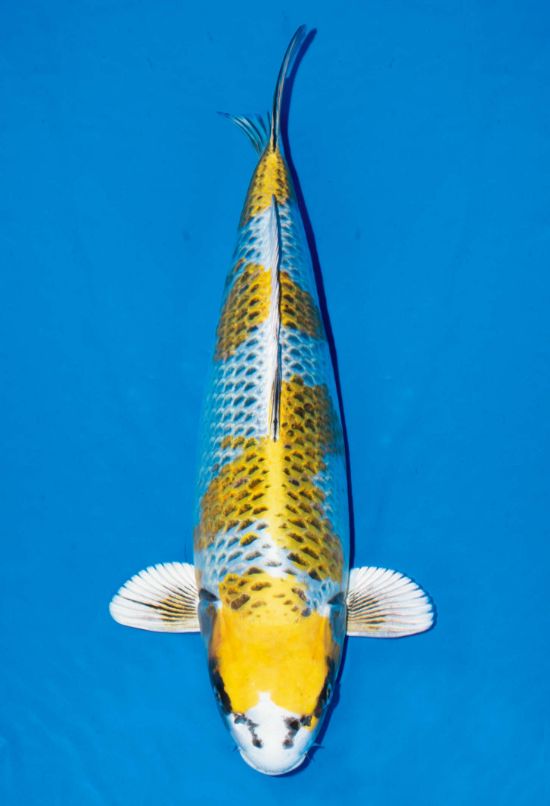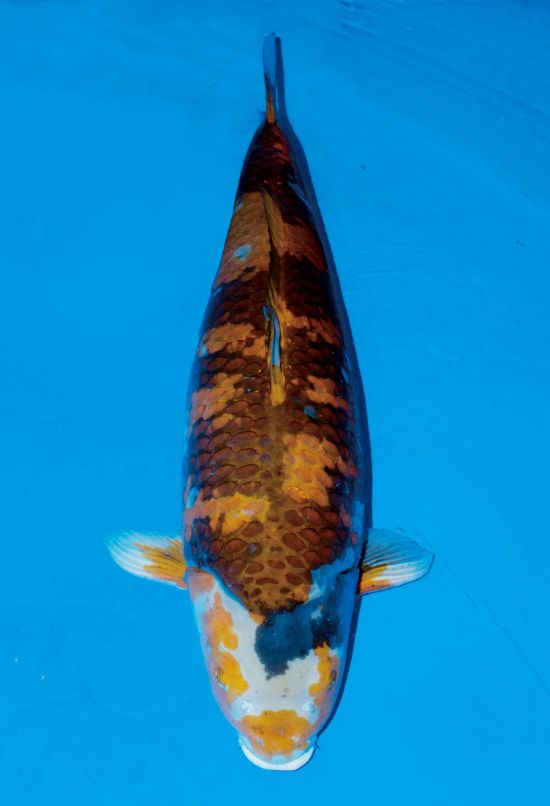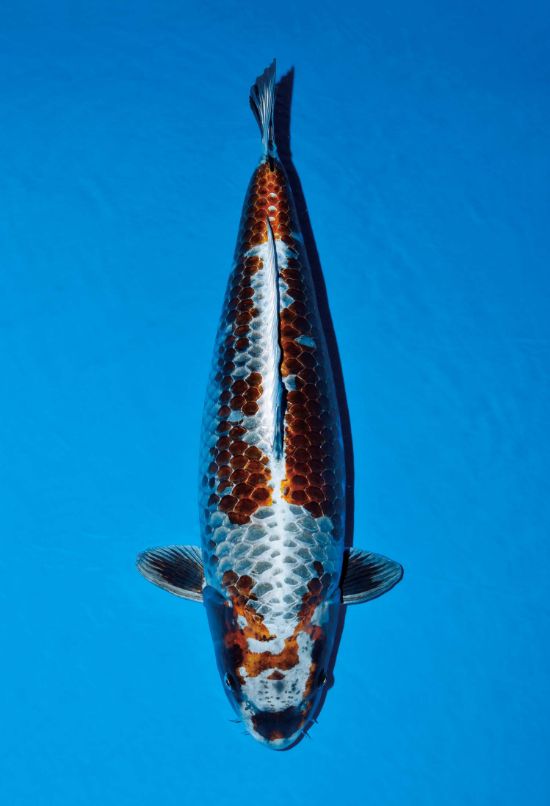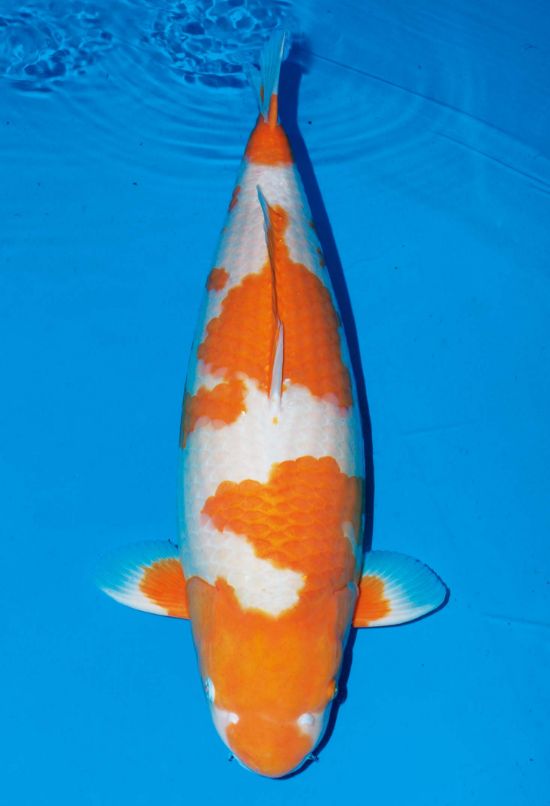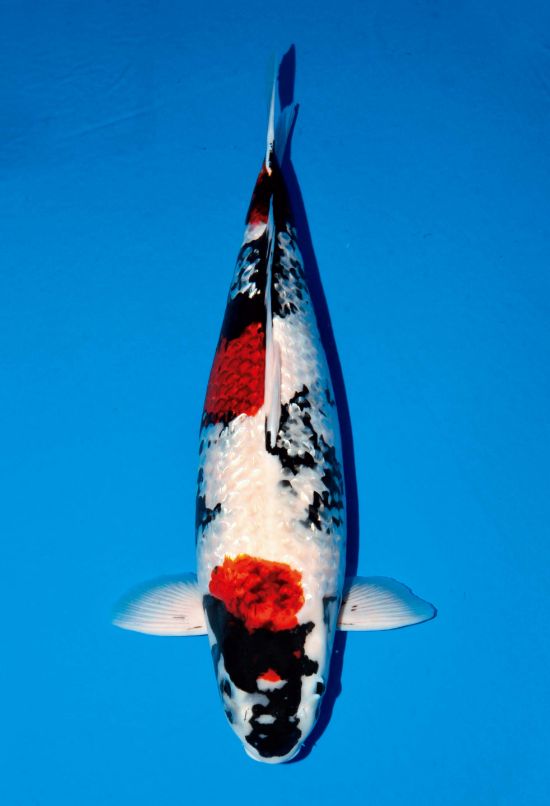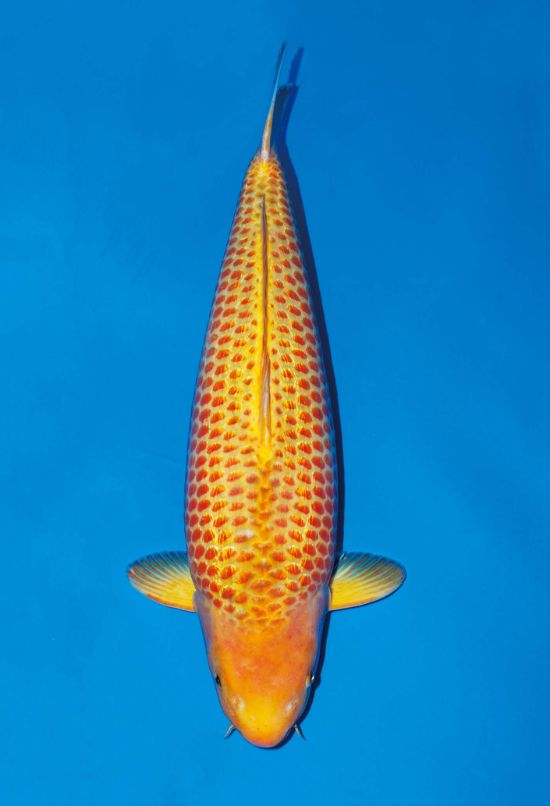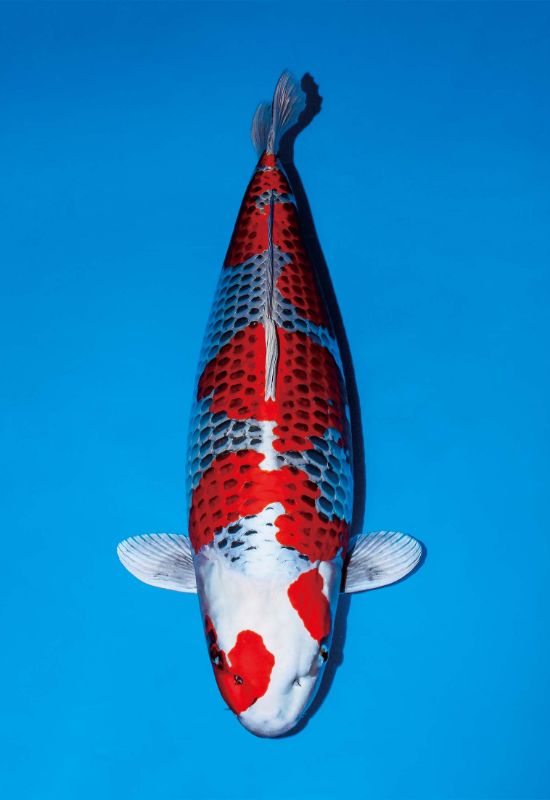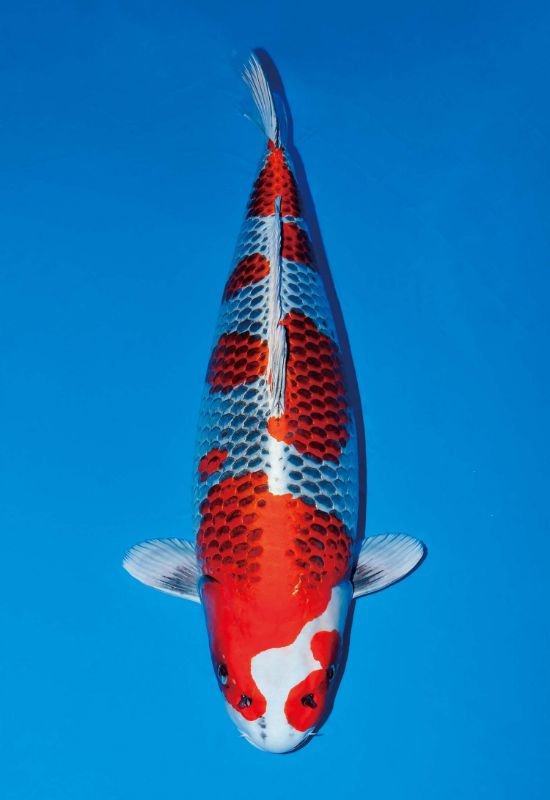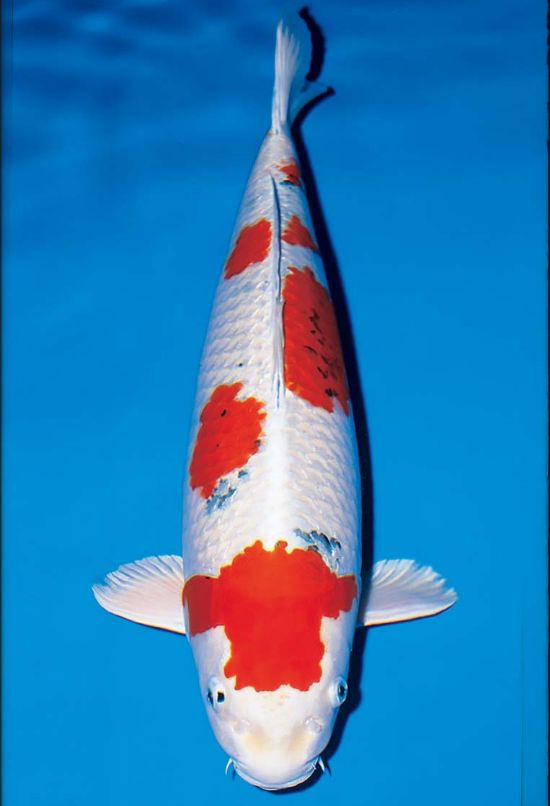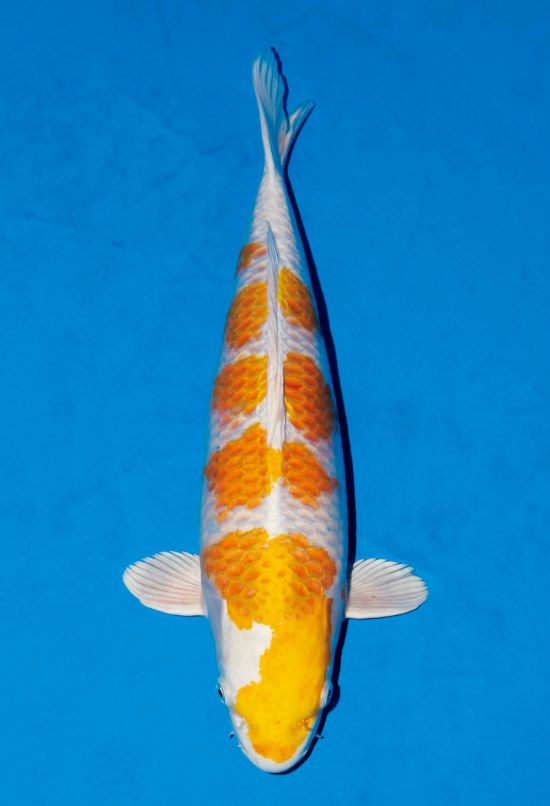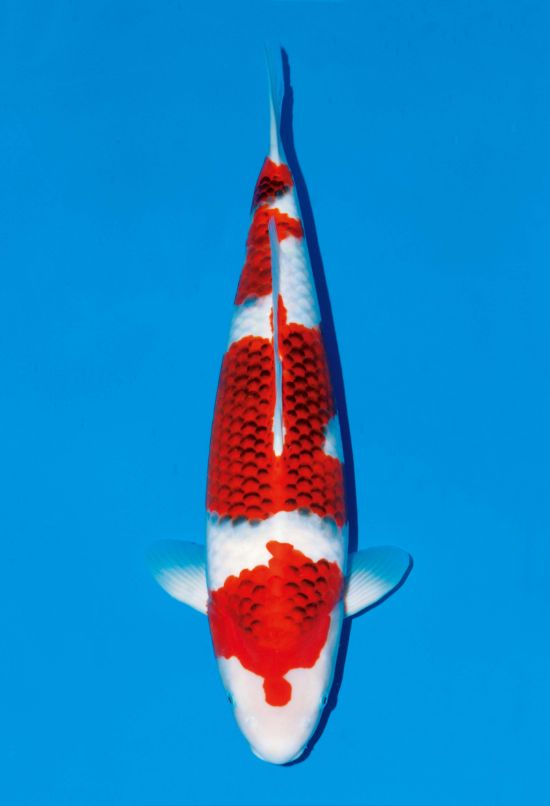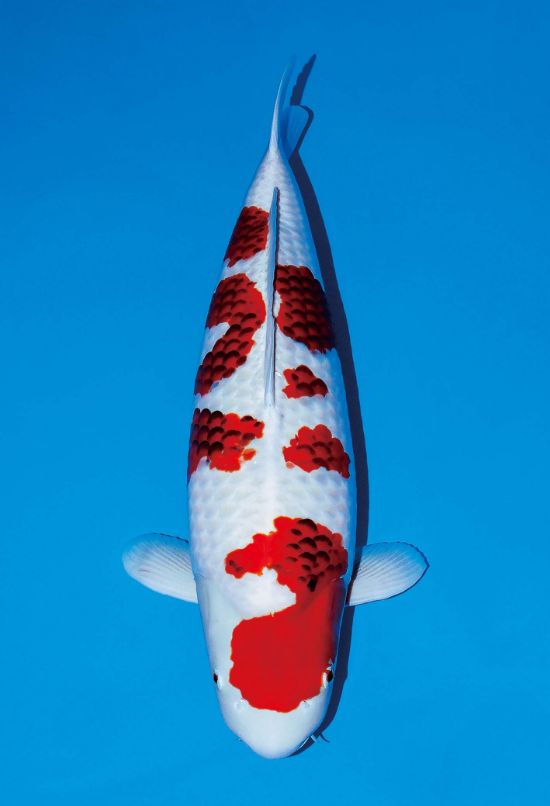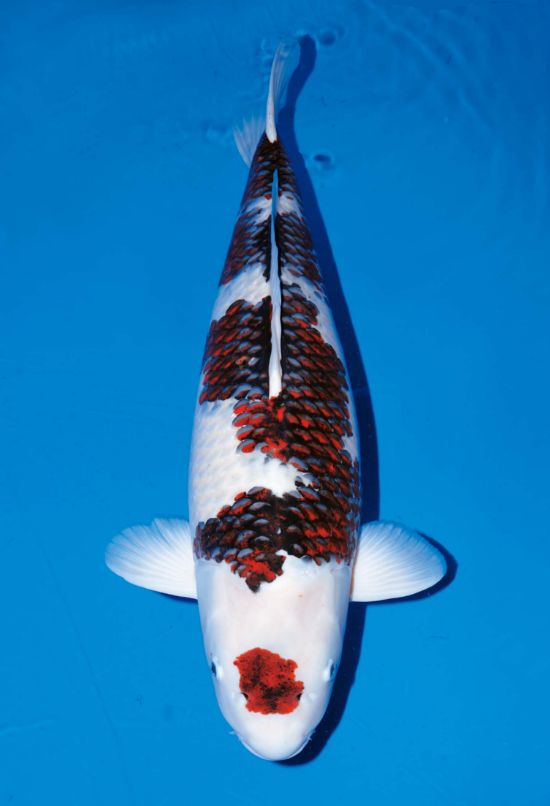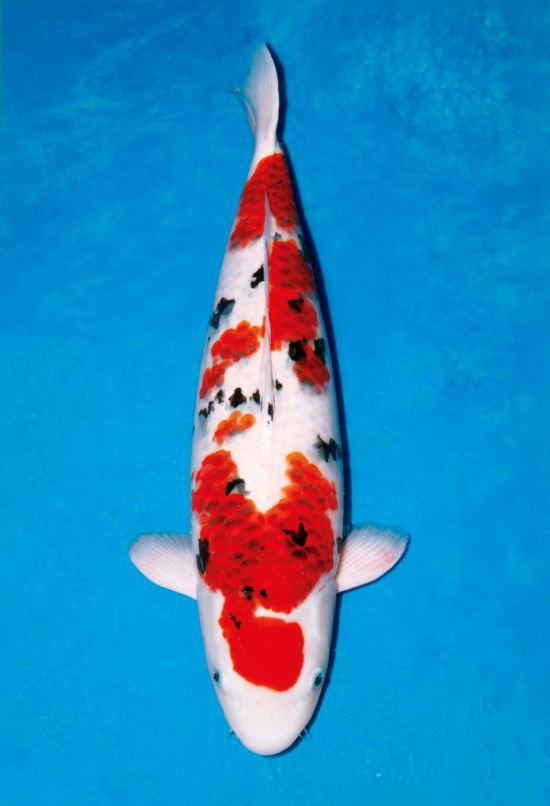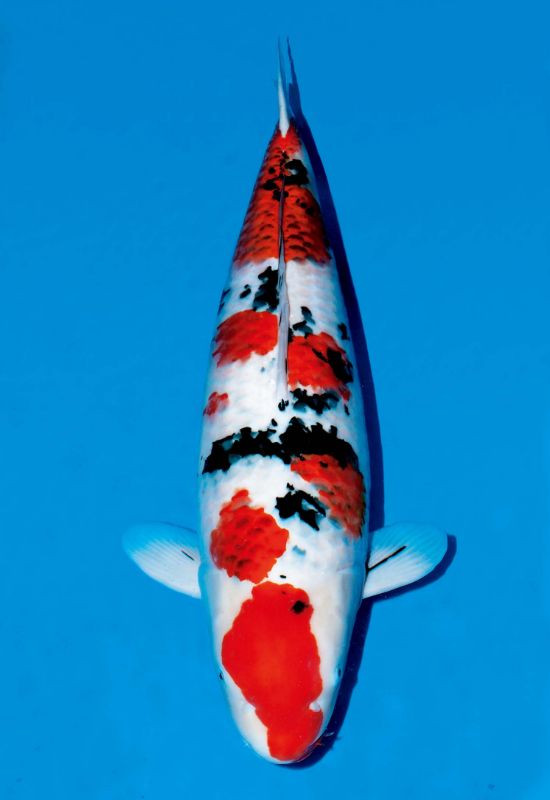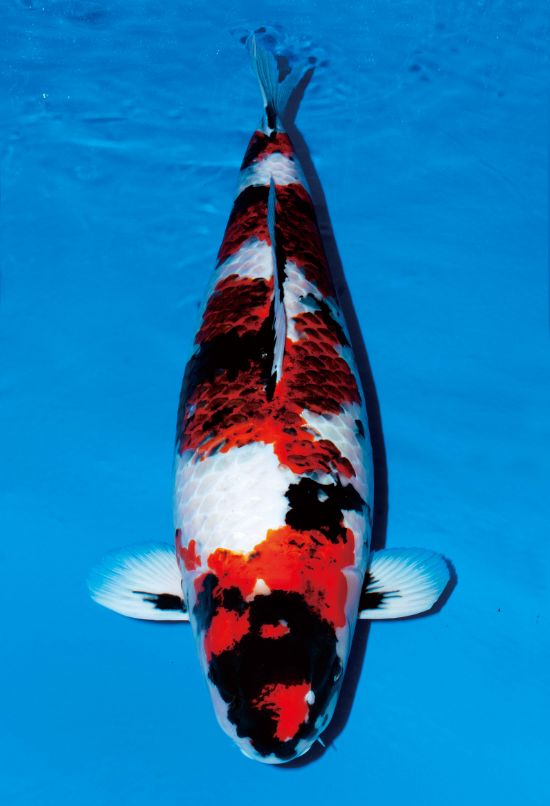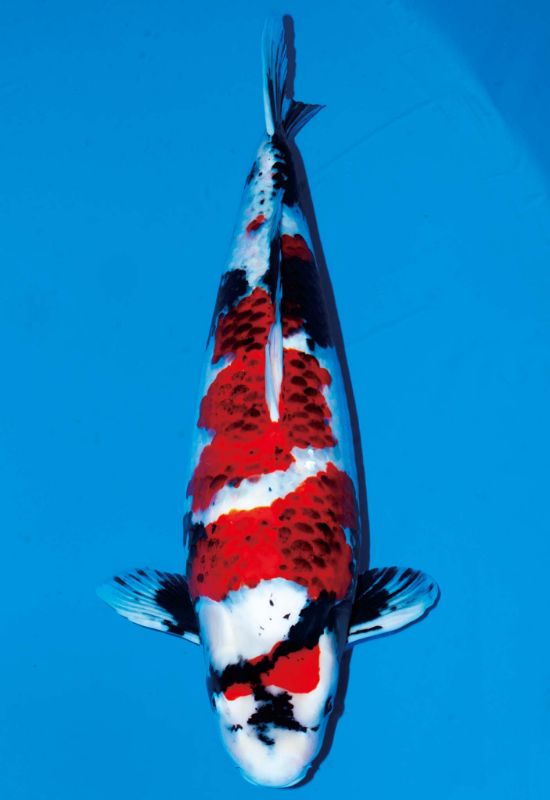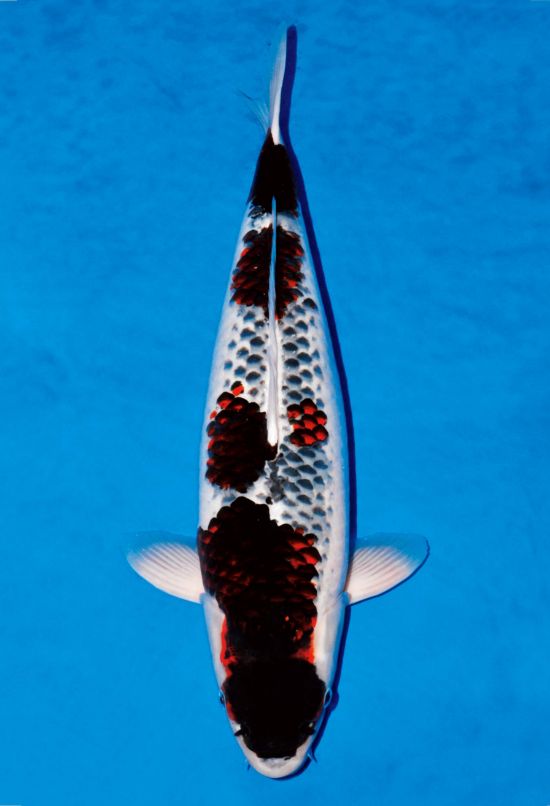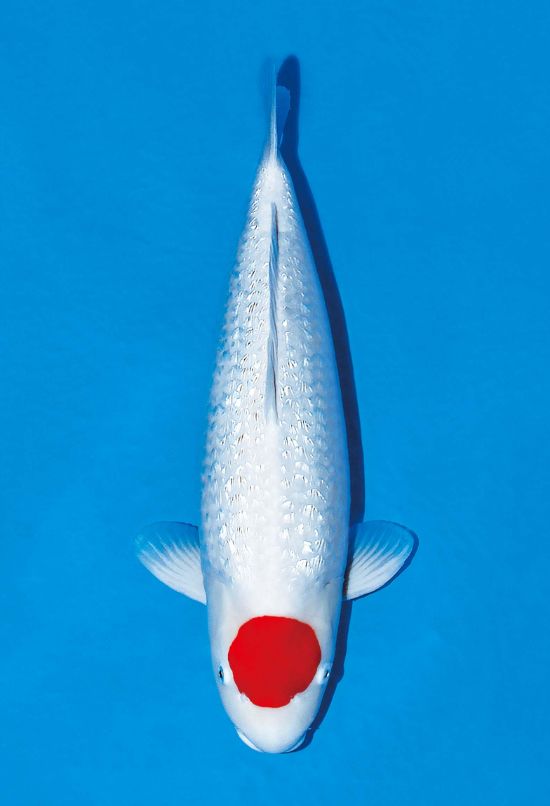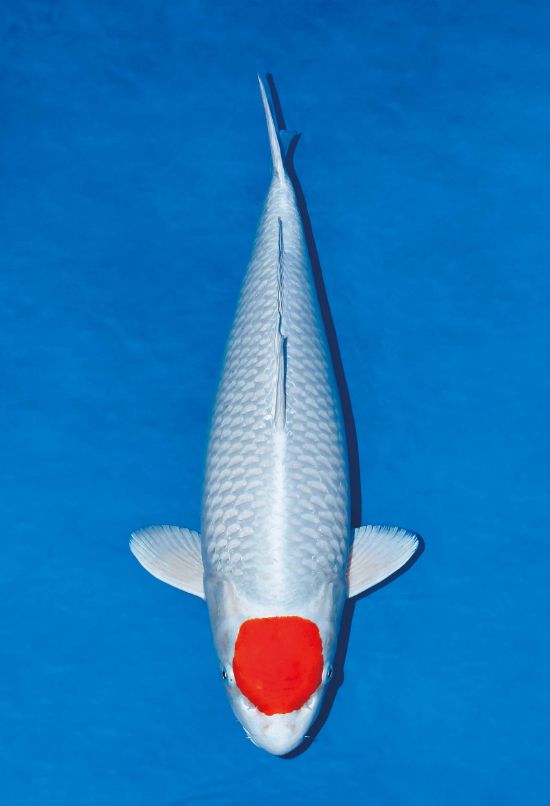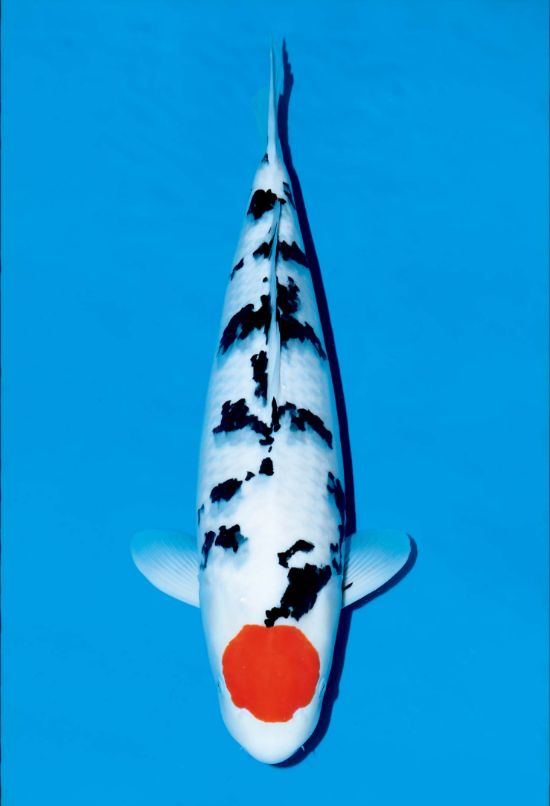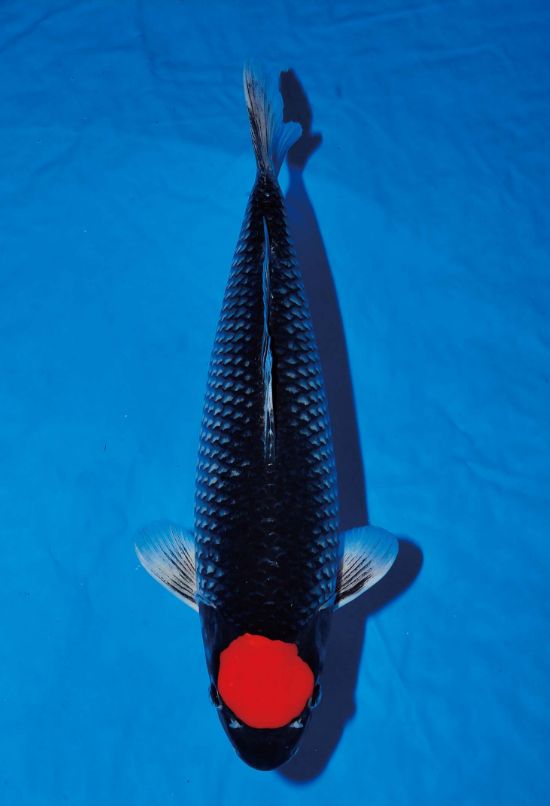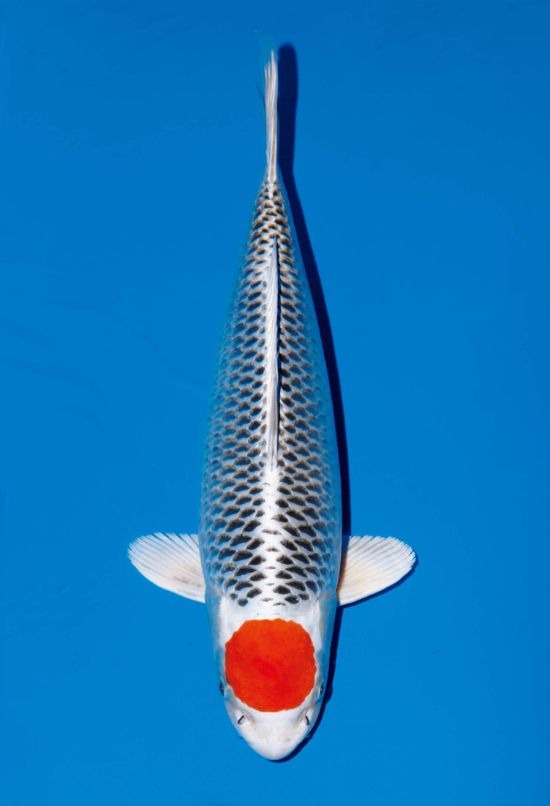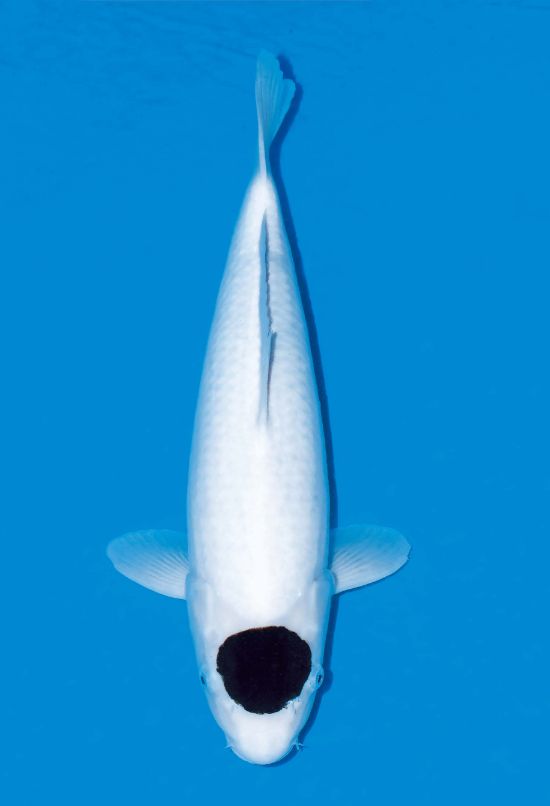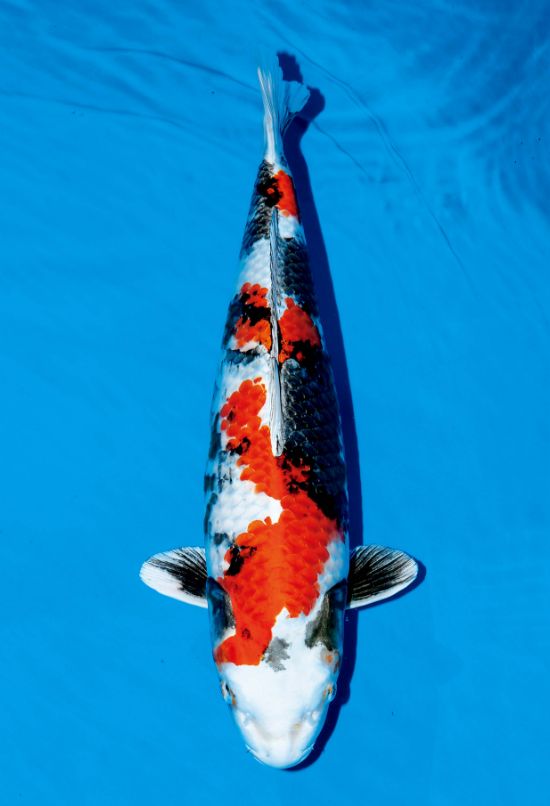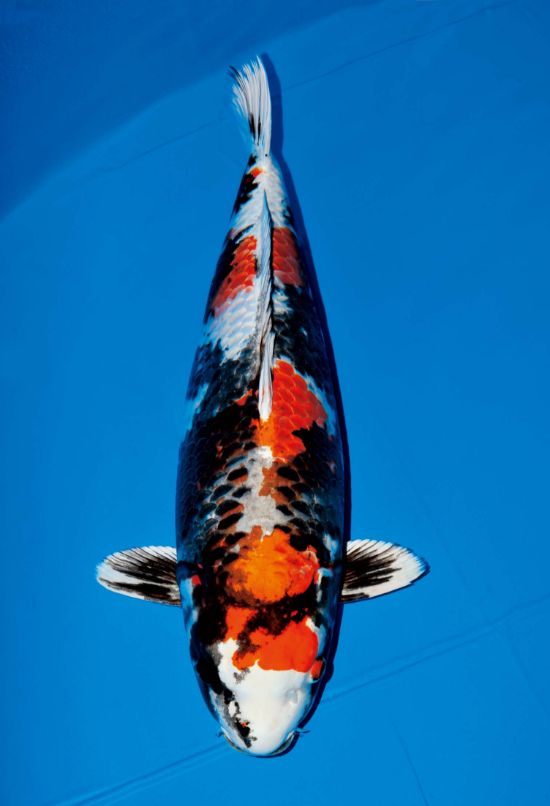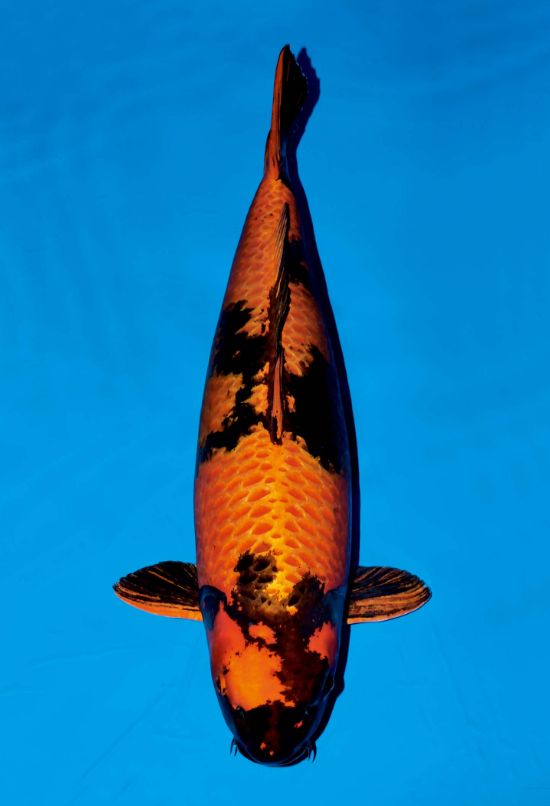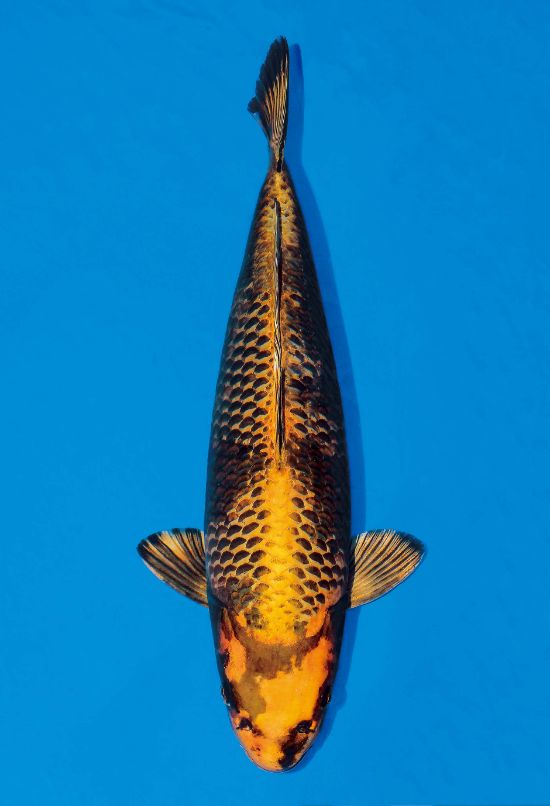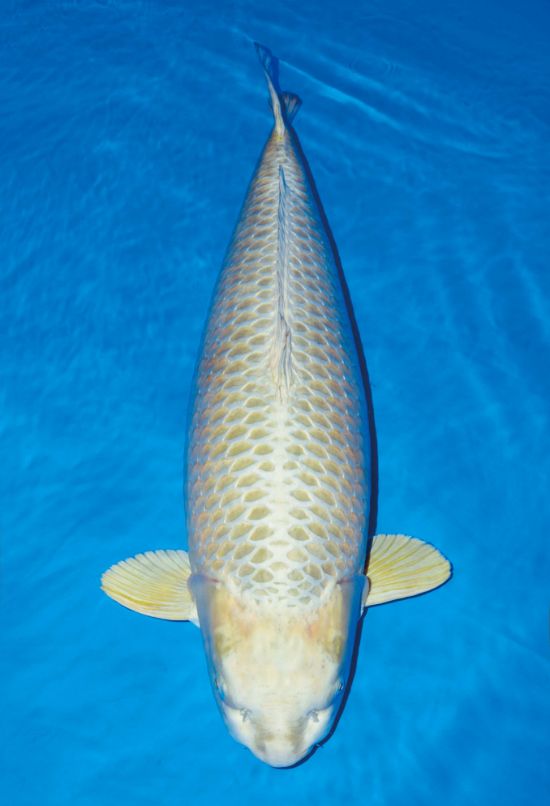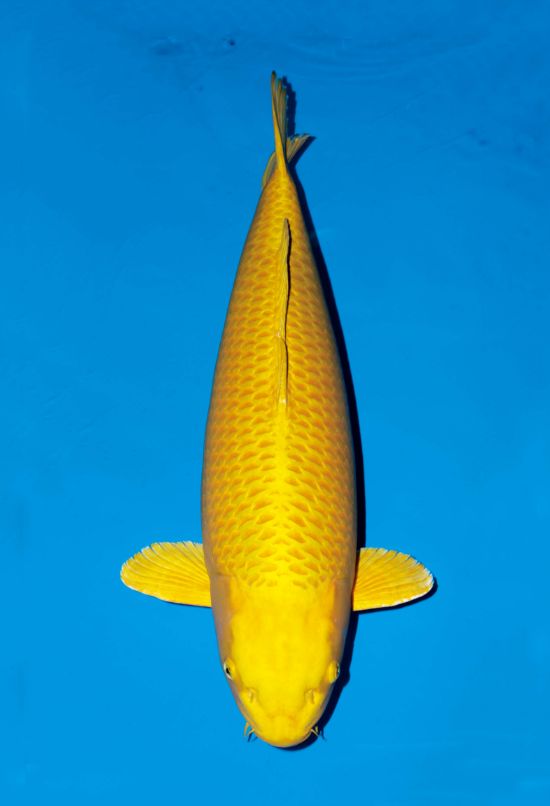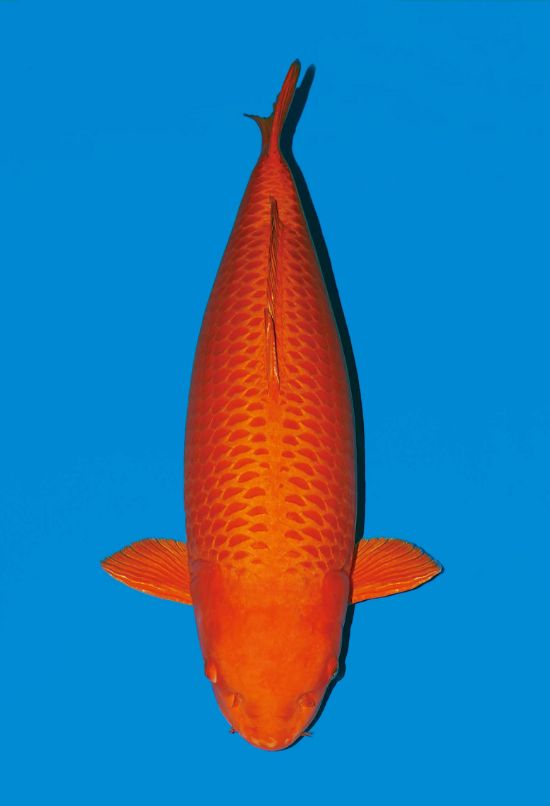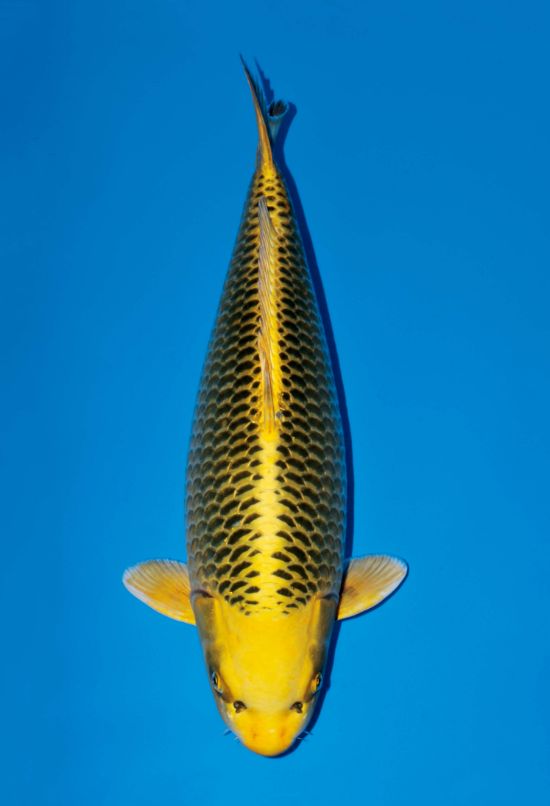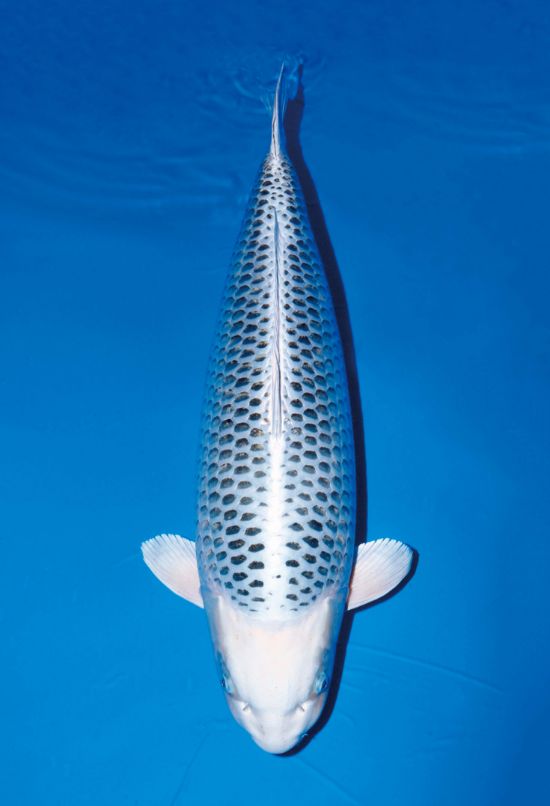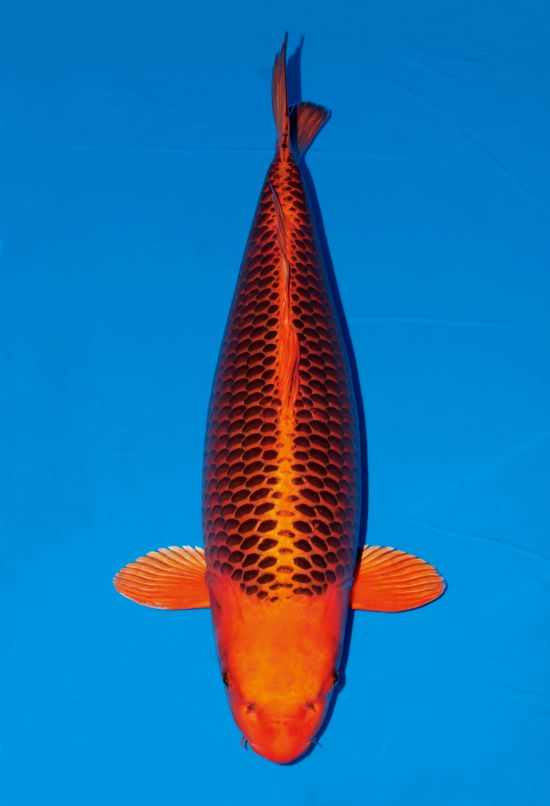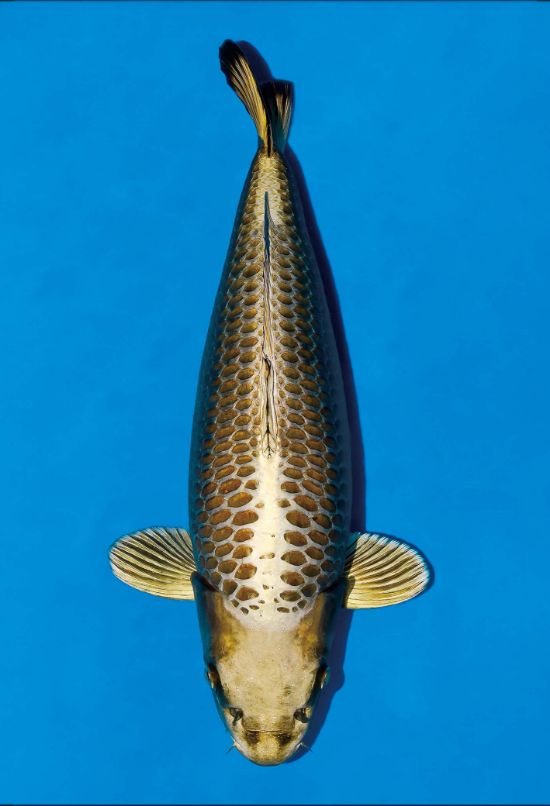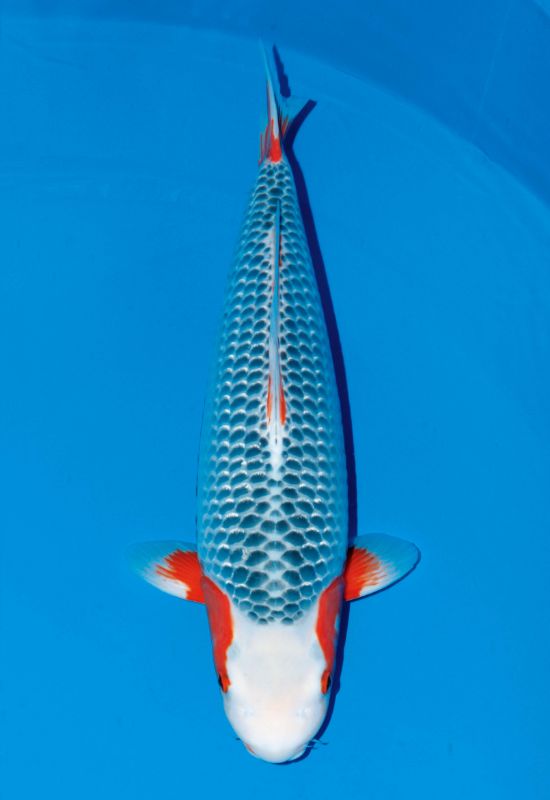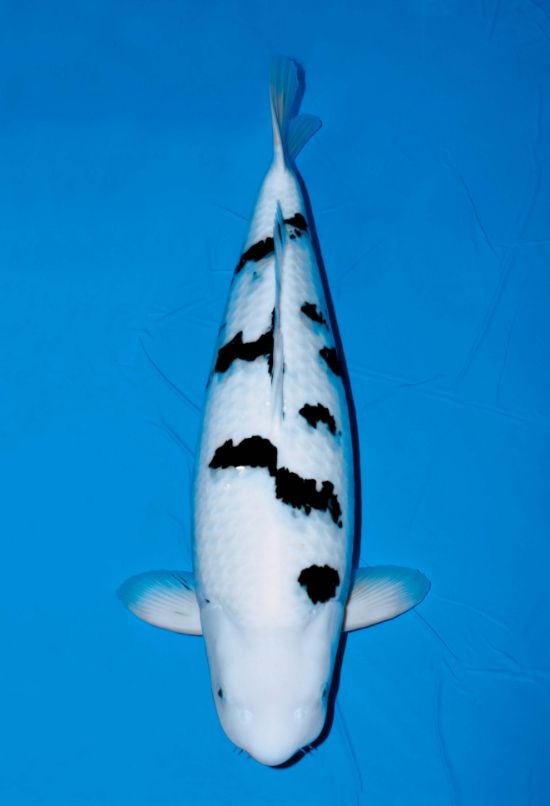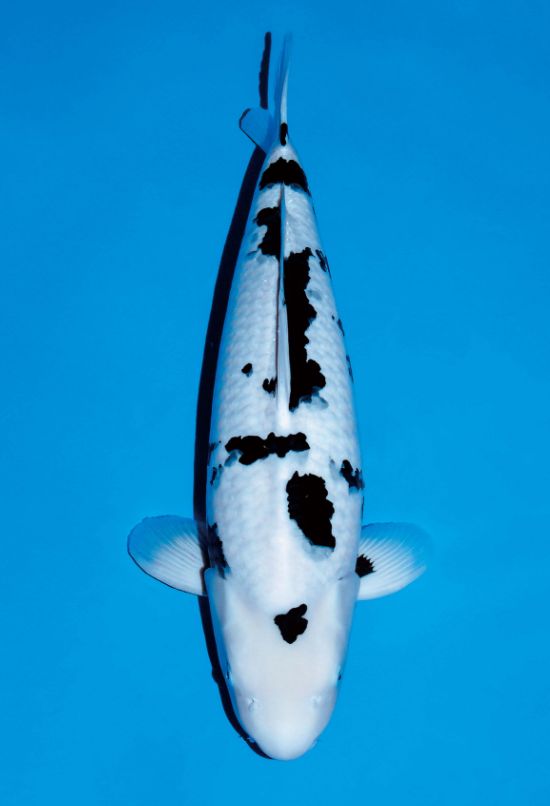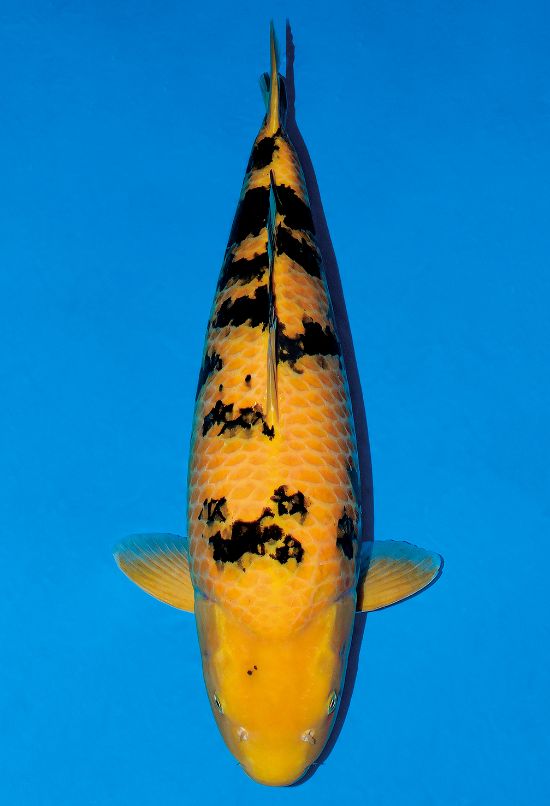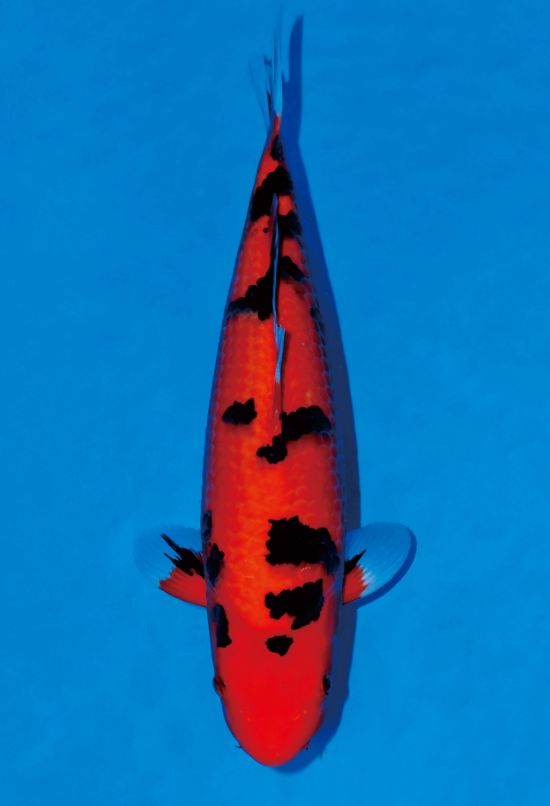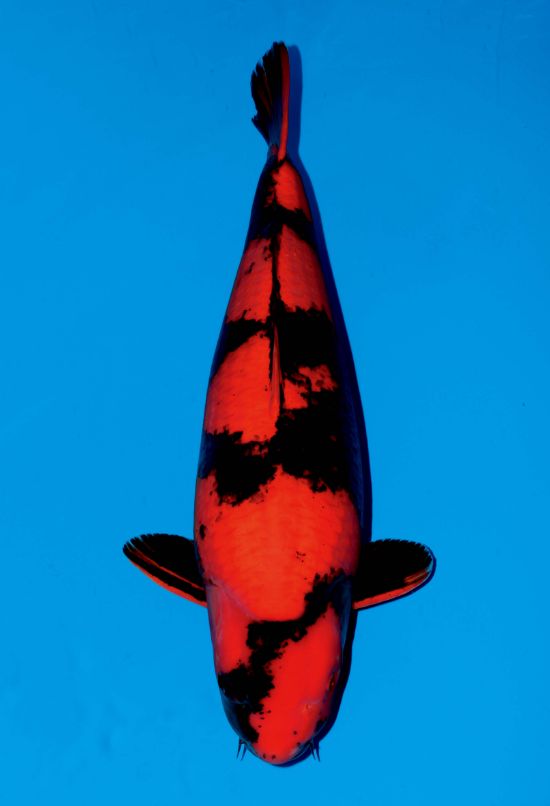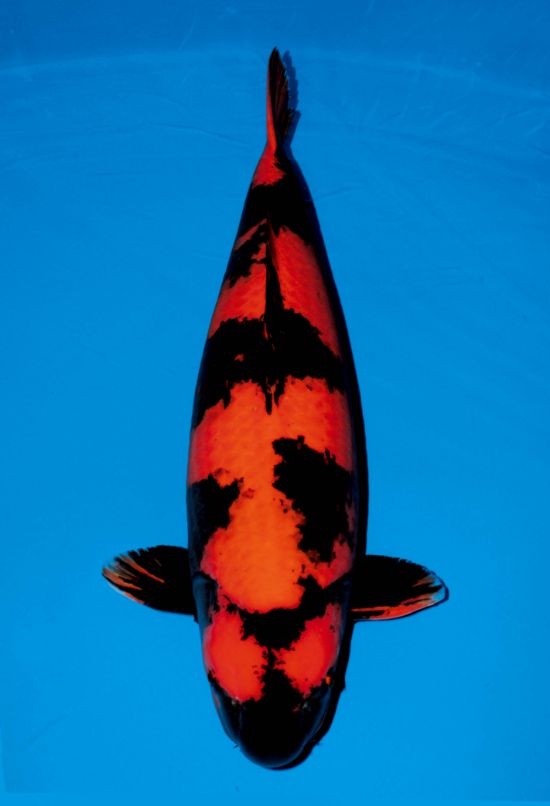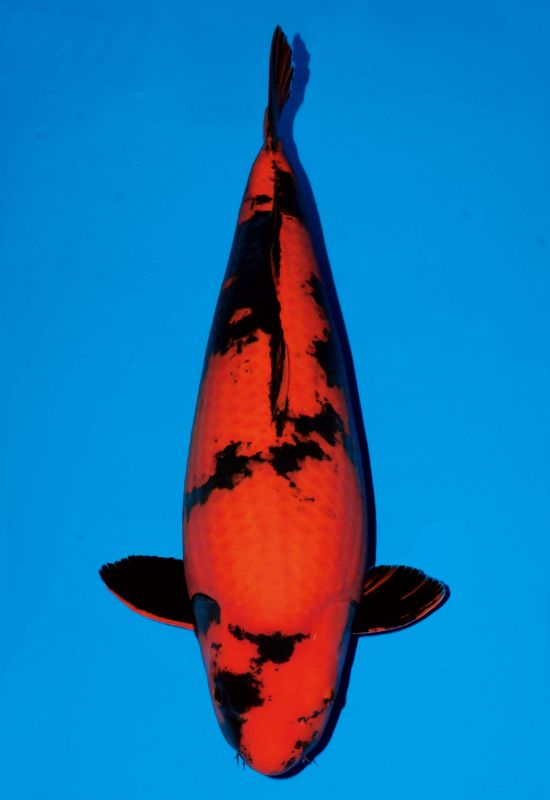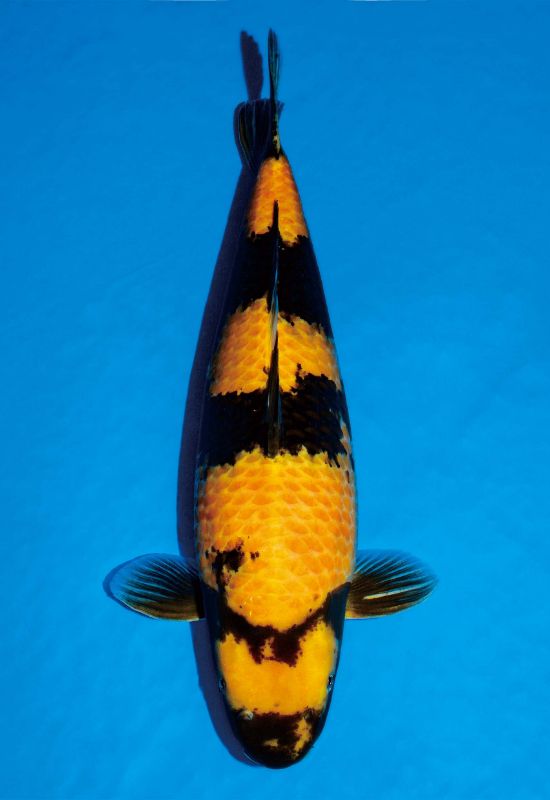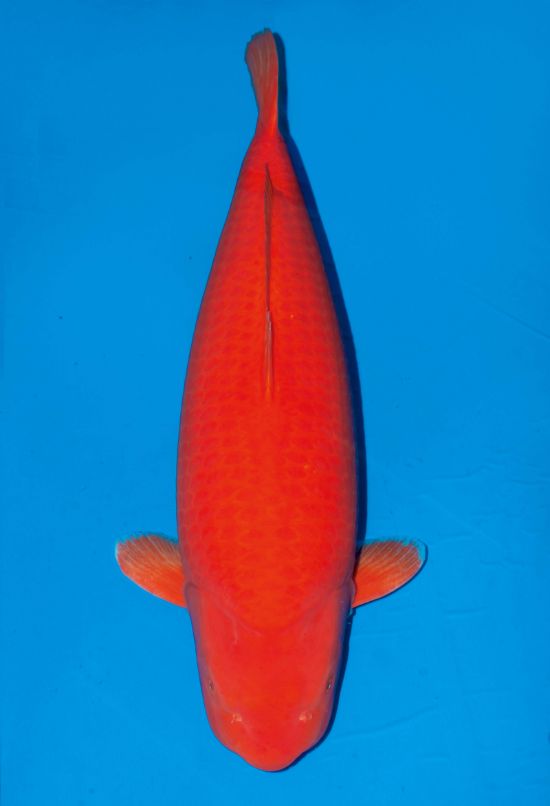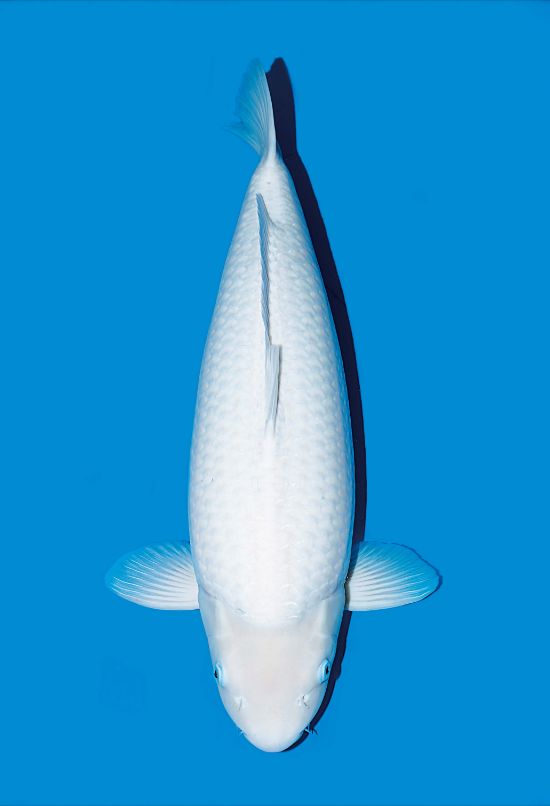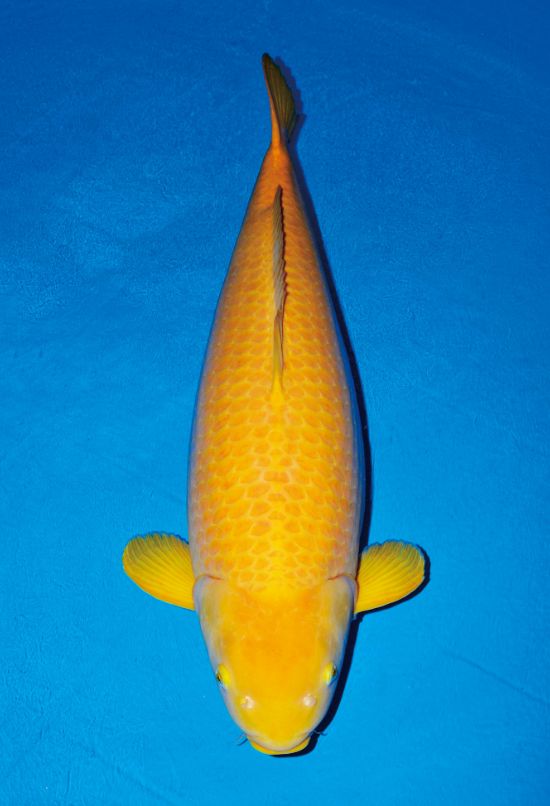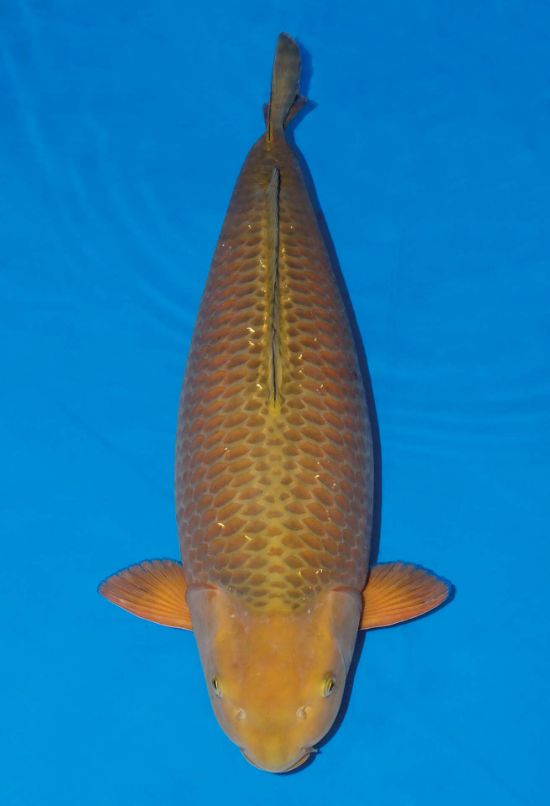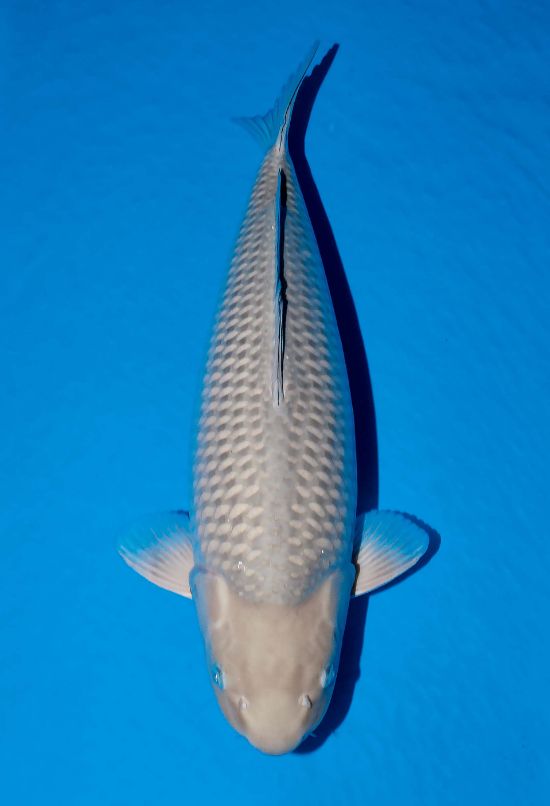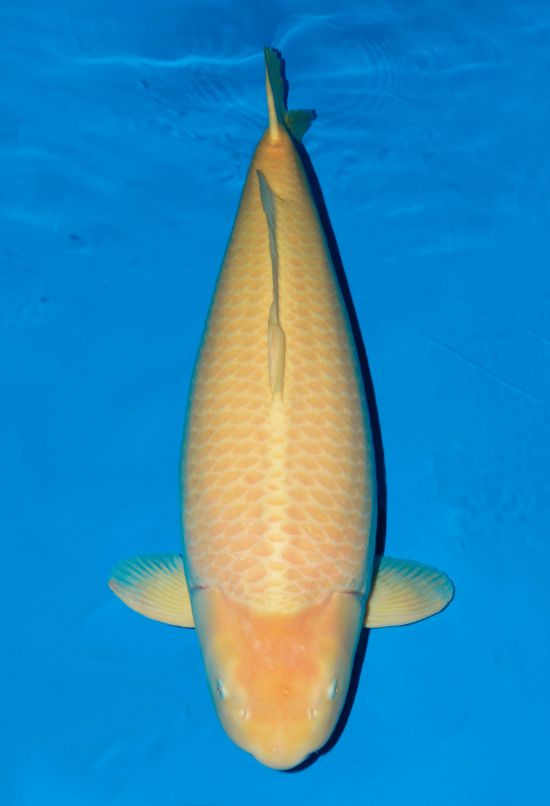Kohaku
Kohaku is characterized by red imprints across the white body. It is said that various Nishikigoi varieties were born based on Kohaku. Although the body color of Kohaku is a simple color scheme of white and red, the atmosphere created from it is diverse, and it is even said that the viewing of Koi begins with Kohaku and ends with Kohaku.
Kohaku with a clear white background and dark and bright red imprints are considered to be good, and those with a clear boundary (called “kiwa” in Japanese) between the white background and red imprints are considered to be excellent products. There are various variations of the shape of the red imprints, such as “Ni-dan”, “San-dan”, “lnazuma”, and “Maruten” called in Japanese.
- JAS No.2001 Kohaku
- Kohaku has a white body (white background), and there are red or scarlet imprints called "hiban" in Japanese across the body.
Taisho-sanshoku
Taisho-sanshoku basically has a Kohaku color pattern, and it has black imprints called “urushizumi” in Japanese, which is a characteristic of this variety. It was named Taisho-sanshoku because it was produced in the beginning of the Taisho period in the history of Japan, along with the three colors of the white background and red and black imprints seen in this carp.
The ideal Taisho-sanshoku is considered to be based on the pattern of the Kohaku, with shiny black imprints placed in good balance across the body.
- JAS No.2002 Taisho-sanshoku
- Taisho-sanshoku has a white body, and there are scarlet and black imprints across the body.
Showa-sanshoku
Showa-sanshoku is characterized by having a continuous shape of “Utsurizumi” derived from the black background, and it was named Showa-sanshoku because it was produced at the beginning of the Showa period in the history of Japan.
For Showa-sanshoku, it is said that the one with the ink-colored pattern that rolls up from the belly to the back and the ink-colored pattern that splits the face in half is good.
Showa-sanshoku tends to have headband-shaped ink patterns on its head, and the base of the pectoral fins is characterized by being blackened.
- JAS No.2003 Showa-sanshoku
- Showa-sanshoku has a black body (black background), and there are scarlet and white imprints across the body. In general, the base of the pectoral fin is on a black background, but in the process of growth, there are some that change from a white background to a black background. There are also individuals with a continuous black background that does not have a mottled shape called "utsuri-zumi" in Japanese.
Shiroutsuri
Shiroutsuri is a variety that has a continuous pattern of Utsurizumi, which is derived from the black background, just like Showa-sanshoku. The white and black body color is monotone with no red imprints. It looks similar to the “white tortoiseshell” that will be introduced later, but the color of the ink is different. It is easy to understand if you remember that Showa-sanshoku without the red imprints is Shiroutsuri, and Taisho-sanshoku without the red imprints is Shiro-bekko.
For Shiroutsuri, it is said that the one with more white imprints and the ink pattern that is well-proportioned from head to tail and swirls up is good.
- JAS No.2004 Shiroutsuri
- Shiroutsuri has a black body, and there are white imprints across the body. There are also individuals that have "utsuri-zumi"across the body. Similar to Bekko, but distinguishable from the black background.
Goshiki
Goshiki was produced by crossbreeding Asagi and Taisho-sanshoku, and it is named after the five colors of blue and dark blue that Asagi has and Taisho-sanshoku has white, red and black. Today, regardless of these five colors, individuals that have pale yellow patterns and red imprints on a white background are called Goshiki. In addition, depending on the appearance of colors and patterns, there are also things called "Mameshibori-goshiki", "Black-goshiki", "Goshiki-sanshoku", and "Goshiki-showa".
The splendid Goshiki are said to have a uniform black or bluish-white light-yellow background all over the body, and the red pattern to be black, clean, and with a clear contrast.
- JAS No.2005 Goshiki
- Goshiki has an indigo or light blue body, except for the head. It has a mesh pattern on the entire back due to the arrangement of scales called "asagidi" in Japanese. Some individuals has a scarlet imprints across the body, and scarlet imprints have indigo or light blue and some do not. Some have black imprints. It is similar to Koromo, but it can be distinguished from the Goshiki that it is "asagidi".
Goshiki-sanshoku
Goshiki-sanshoku has the appearance characteristics of Taisho-sanshoku and has a "asagidi" pattern. Some scarlet imprints have indigo or light blue, while others do not.
Goshiki-showa
Goshiki-showa has the appearance characteristics of Showa-sanshoku and has a "asagidi" pattern. Some scarlet imprints have indigo or light blue, while others do not.
A-ginrin
A-Ginrin is the name given to individuals with shining scales that have the characteristics of the Gosanke (Kohaku, Taisho-sanshoku, Showa-sanshoku). Ginrin refers to those developed so that only the scales shine in gold or silver. There are varieties such as Ginrin-kohaku, Ginrin-taisho-sanshoku and Ginrin-showa-sanshoku. Among these varieties, the one with the brightest light is called Diamond-ginrin, and the one with a round central part is called Pearl-ginrin.
It is said that the ones with shining scales neatly arranged all over the body and the ones with strong light are good.
- JAS No.2006 A-ginrin
- Nishikigoi belonging to A-ginrin has shine golden scales on the scarlet imprints or silver scales on the white body, and those having the appearance characteristics of Kohaku, Taisho-sanshoku, or Showa-sanshok.
Ginrin-kohaku
Ginrin-kohaku has shine golden or silver scales, and has the appearance characteristics of Kohaku.
Pearl-ginrin-kohaku
Pearl-ginrin-kohaku has scales that shine round and golden or silver in the center, and has the appearance characteristics of Kohaku.
Ginrin-taisho-sanshoku
Ginrin-taisho-sanshoku has shine golden or silver scales, and has the appearance characteristics of Taisho-sanshoku.
Pearl-ginrin-taisho-sanshoku
Pearl-ginrin-taisho-sanshoku has scales that shine round and golden or silver in the center, and has the appearance characteristics of Taisho-sanshoku.
Ginrin-showa-sanshoku
Ginrin-showa-sanshoku has shine golden or silver scales, and has the appearance characteristics of Showa-sanshoku.
B-ginrin
B-ginrin is the name of an individual with shining scales that shows the characteristics of breeds other than the Gosanke (Kohaku, Taisho-sanshoku, Showa-sanshoku). There are varieties such as Ginrin-shiroutsuri, Ginrin-goshiki, Ginrin-asagi, and Ginrin-ochiba, and it is a breed that represents the splendor of Nishikigoi along with Hikari-moyo.
Like "A-Ginrin", it is said to be good if the shining scales are neatly arranged all over the body and the light is strong.
- JAS No.2007 B-ginrin
- Nishikigoi belonging to B-ginrin has shine golden scales (on the scarlet imprints, etc.) or silver scales (on the white backgrounds, etc.), excluding nishikigoi belonging to A-ginrin.
Ginrin-sakura-ogon
Ginrin-sakura-ogon has shine golden or silver scales, and has the appearance characteristics of Sakura-ogon.
Ginrin-kin-showa
Ginrin-kin-showa has shine golden or silver scales, and has the appearance characteristics of Kin-Showa.
Ginrin-shiroutsuri
Ginrin-shiroutsuri has shine silver scales, and has the appearance characteristics of Shiroutsuri.
Ginrin-goshiki
Ginrin-goshiki has shine golden or silver scales, and has the appearance characteristics of Goshiki.
Ginrin-kujaku
Ginrin-kujaku has shine golden or silver scales, and has the appearance characteristics of Kujaku.
Ginrin-ai-goromo
Ginrin-ai-goromo has shine golden or silver scales, and has the appearance characteristics of Ai-goromo.
Ginrin-budo-goromo
Ginrin-budo-goromo has shine golden or silver scales, and has the appearance characteristics of Budo-goromo.
Ginrin-yamabuki-ogon
Ginrin-yamabuki-ogon has shine golden or silver scales, and has the appearance characteristics of Yamabuki-ogon.
Ginrin-platinum-ogon
Ginrin-platinum-ogon has shine silver scales, and has the appearance characteristics of Platinum-ogon.
Ginrin-orange-ogon
Ginrin-orange-ogon has shine golden or silver scales, and has the appearance characteristics of Orange-ogon.
Ginrin-asagi
Ginrin-asagi has shine silver scales, and has the appearance characteristics of Asagi.
Ginrin-yuki-asagi
Ginrin-yuki-asagi has a white body and shine silver scales. It has red imprints on the belly.
Ginrin-shiro-bekko
Ginrin-shiro-bekko has shine silver scales, and has the appearance characteristics of Shiro-bekko.
Ginrin-hiutsuri
Ginrin-hiutsuri has shine golden or silver scales, and has the appearance characteristics of Hiutsuri.
Ginrin-kiutsuri
Ginrin-kiutsuri has shine golden or silver scales, and has the appearance characteristics of Kiutsuri.
Ginrin-aka-muji
Ginrin-aka-muji has shine golden or silver scales, and has the appearance characteristics of Aka-muji.
Ginrin-shiro-muji
Ginrin-shiro-muji has shine silver scales, and has the appearance characteristics of Shiro-muji.
Ginrin-kigoi
Ginrin-kigoi has shine golden or silver scales, and those having the appearance characteristics of Kigoi.
Ginrin-chagoi
Ginrin-chagoi has shine golden or silver scales, and has the appearance characteristics of Chagoi.
Ginrin-soragoi
Ginrin-soragoi has shine golden or silver scales, and has the appearance characteristics of Soragoi.
Ginrin-karashigoi
Ginrin-karashigoi has shine golden or silver scales, and has the appearance characteristics of Karashigoi.
Ginrin-aka-matsuba
Ginrin-aka-matsuba has shine golden or silver scales, and has the appearance characteristics of Aka-matsuba.
Ginrin-ki-matsuba
Ginrin-ki-matsuba has shine golden or silver scales, and has the appearance characteristics of Ki-matsuba.
Ginrin-hajiro
Ginrin-hajiro has shine silver scales, and has the appearance characteristics of Hajiro.
Ginrin-ochiba
Ginrin-ochiba has shine golden or silver scales, and has the appearance characteristics of Ochiba-shigure.
Kanoko-kohaku
Kanoko-kohaku has a white body, and part of the scales is dyed red and has a dotted pattern across the body. Some have scarlet imprints and some do not.
Kanoko-sanshoku
Kanoko-sanshoku has the appearance characteristics of Taisho-sansoku, with part of the scales dyed red and a dotted pattern across the body.
Kanoko-showa
Kanoko-showa has the appearance characteristics of Showa-sansoku, with part of the scales dyed red and a dotted pattern across the body.
Kanoko-asagi
Kanoko-asagi has the appearance characteristics of Asagi, with part of the scales dyed red and a dotted pattern across the body.
Kanoko-kin-showa
Kanoko-kin-showa has the appearance characteristics of Kanoko-showa, and the whole body shines brightly.
Goshiki-shigure
Goshiki-shigure has an "asagidi" pattern and yellow imprints across the body. It is gently glowing all over.
Kage-showa
Kage-showa has a black body, and there are scarlet and white imprints across the body. It has a mesh-like thin ink pattern in the scarlet and white imprints.
Kage-shiroutsuri
Kage-shiroutsuri has a black body, and there are white imprints across the body. It has a mesh-like ink pattern on white imprints and "utsuri-zumi" pattern.
Kage-hiutsuri
Kage-hiutsuri has a black body, and there are red scarlet imprints across the body. It has a mesh-like ink pattern on red scarlet imprints and "utsuri-zumi" pattern.
Kage-kiutsuri
Kage-kiutsuri has a black body, and there are yellow imprints across the body. It has a mesh-like ink pattern on yellow imprints and “utsuri-zumi” pattern.
Cha-utsuri
Cha-utsuri has a black body, and there are brown or reddish brown imprints across the body. It has a "utsuri-zumi" pattern.
Hajiro
Hajiro has white pectoral fins, and the whole body is jet black except for pectoral fins. In some individuals, part of the pectoral fin turns black.
Beni-matsukawa-bake
Beni-matsukawa-bake has scarlet patterns on the body, and the appearance characteristics of Matsukawa-bake.
Matsukawa-bake
Matsukawa-bake has white and jet black patterns across the body, and the whole body except for the head is covered with scales. Due to changes in the environment in which they live, the jet-black pattern may change frequently in a short period of time.
Ginga
Ginga has a white body and shiny scales all over the body It has an ”asagidi" pattern across the body.
Beni-ginga
Beni-ginga has a white body and shiny scales all over the body It has an ”asagidi" pattern and red imprints across the body.
Kirin
Kirin has golden imprints across the body, and the whole body is shining. In Kirin, part of the scales are dyed in light black, and the entire body has a mesh pattern.
Ochiba-shigure
Ochiba-shigure has a light pale yellow body, and there are earthenware color imprints across the body. It has a mesh-like pattern on the entire back due to the arrangement of scales.
Ochiba-utsuri
Ochiba-utsuri has a light pale yellow body, and there are earthenware color and black imprints across the body. It has a mesh-like pattern on the entire back due to the arrangement of scales.
Kogane-ochiba
The whole body of Kogane-ochiba shines brightly, and those having the appearance characteristics of Ochiba-shigure.
Koyo
Koyo has a white background or a color close to white with yellow imprints across the body.
Midori-goi
Midori-goi has a yellow body with no imprints, and a olive-green back or green scales on the back.
Ginrin-koromo-showa
Ginrin-koromo-showa has shine golden or silver scales, and has the appearance characteristics of Koromo-showa.
Ginrin-kanoko-karashi
Ginrin-kanoko-karashi has shine golden or silver scales, and has mustard-colored body. It has a reddish dotted pattern on some of its scales. Some individuals have mustard-colored imprints and red dotted pattern on the body. It is commonly called to as "golden-corn" because of its external characteristics.
Kujaku
Kujaku was produced based on Asagi, and is a variety that has added the characteristics of Hikari-moyo and red imprints through crossbreeding. Kujaku means peacock in Japanese, and the name Kujaku comes from the association with the beauty of the peacock when it opens its wings, and it is also called Kujaku-ogon.
A good Kujaku is said to have a metallic sheen all over its body, and a well-balanced pattern of red imprints on its body, which has a distinct mesh pattern of scales.
- JAS No.2009 Kujaku
- Kujaku has an ”asagidi" pattern and scarlet imprints on the back, and its whole body shines.
Sakura-ogon
Sakura-ogon has the appearance characteristics of Kohaku, and the whole body shines brightly. It is also called Platinum-kohaku in Japan.
Yamatonishiki
Yamatonishiki has the appearance characteristics of Taisho-sanshoku, and the whole body shines brightly.
Hariwake-ogon
Hariwake-ogon has a white body and scales on its body. There are golden imprints across the body, and the whole body shines brightly.
Koromo
Koromo is an improved variety of Kohaku, and the tip of the red scales is half-moon shaped and dyed indigo or black. It was named Koromo because of the pattern of the scales. There are varieties called Ai-goromo and Budo-goromo depending on the color of the pattern on the body. In addition, there are Koromo-sanshoku, in which indigo is layered over the color pattern of Taisho-sanshoku, and Koromo-showa, in which the color pattern of Showa-sanshoku are layered with indigo.
Good koromo is considered to have a red and white pattern with each red scale and a uniform crescent-shaped indigo base.
- JAS No.2013 Koromo
- Koromo has scarlet imprints across the body, the tips of the scales on the scarlet imprints are dyed indigo or black in a half-moon shape. It is similar to Goshiki, but it can be distinguished from the fact that Koromo does not have an ”asagidi" pattern on the white part of the body.
Ai-goromo
Ai-goromo has a white body, and there are scarlet imprints across the body. The tips of the scales on the scarlet imprints are dyed indigo in a half-moon shape.
Budo-goromo
Budo-goromo has a white body, and there are reddish brown imprints across the body. It has a black pattern of grape tufts throughout the imprints.
Koromo-sanshoku
Koromo-sanshoku has the appearance characteristics of the Taisho-sanshoku, and has a half-moon-shaped scale that is dyed indigo on the scarlet imprints.
Koromo-showa
Koromo-showa has the appearance characteristics of the Showa-sanshoku, and has a half-moon-shaped scale that is dyed indigo on the scarlet imprints.
Shunrai
Shunrai has a white body, and there are scarlet imprints across the body. The tips of the scales on the scarlet imprints or on the dorsal surface are dyed black in a half-moon shape.
Tancho
Tancho has only one red, round pattern on its head, and was named Tancho after the bird Tancho crane. The word "Tancho" generally means Tancho-kohaku and is popular because the red circle pattern on the white body is reminiscent of the Japanese flag. There are many varieties of Tancho, including Tancho-sanshoku, Tancho-showa, and Tancho-goshiki. If the head has a round pattern but the body has a pattern, it does not belong to the Tancho family and is called Maruten or Komaruten.
In Tancho, the red pattern should be close to a perfect circle and located in the center of the head. The size of the red pattern should be neither too large nor too small, but just enough to fit between the two eyes.
- JAS No.2014 Tancho
- Tancho has a circular scarlet imprint on its head. However, circular imprint may be imprints of a color other than scarlet.
Ginrin-tancho-kohaku
Ginrin-tancho-kohaku has shine golden or silver scales, and has the appearance characteristics of Tancho-kohaku.
Tancho-sakura-ogon
Tancho-sakura-ogon has a circular scarlet imprint on its head and has the appearance characteristics of Sakura-ogon.
Tancho-sanshoku
Tancho-sanshoku has a circular scarlet imprint on its head and has the appearance characteristics of Taisho-sanshoku.
Tancho-showa
Tancho-showa has a circular scarlet imprint on its head and has the appearance characteristics of Showa-sanshoku.
Ginrin-tancho-showa
Ginrin-tancho-showa has shine golden or silver scales, and has the appearance characteristics of Tancho-showa.
Tancho-kin-showa
Tancho-kin-showa has shine golden or silver scales, and has the appearance characteristics of Kin-showa.
Tancho-goshiki
Tancho-goshiki has a circular scarlet imprint on its head and has the appearance characteristics of Goshiki.
Tancho-kujaku
Tancho-kujaku has a circular scarlet imprint on its head and has the appearance characteristics of Kujaku.
Tancho-ochiba
Tancho-ochiba has a circular scarlet imprint on its head and has the appearance characteristics of Ochiba-shigure. However, the circular imprint may be of a color other than scarlet.
Tancho-budo-goromo
Tancho-budo-goromo has a circular reddish brown imprint on its head. It has a black pattern of grape tufts throughout the imprint.
Hikari-utsuri
Hikari-utsuri is a generic name for Nishikigoi that are bred from a variety with Utsurizumi such as Showa-sanshoku or Shiroutsuri and Hikari-muji. The merit of Hikari-utsuri is that you can see the sumi's texture on the shiny body. Kin-Showa is a variety that has the Showa-sanshoku pattern and its whole body shines brightly, and Gin-siroutsuri is a variety that has the Shiroutsuri pattern and shines brightly. Kin-kiutsuri is a variety with a shining pattern of Hiutsuri and Kiutsuri.
As with the Hikarimonos, the best ones have a high luster throughout the body, the patterns are well balanced and clearly arranged, and the ink pattern has a dynamic curl from head to tail.
- JAS No.2015 Hikari-utsuri
- Hikari-utsuri has a black body, and has imprints across the body. The whole body shines brightly and it has "utsuri-zumi" pattern across the body.
Kin-showa
Kin-showa has a black body and scales on its body. There are scarlet and white imprints across the body, and the whole body shines brightly. It has "utsuri-zumi" pattern across the body.
Koromo-kin-showa
Koromo-kin-showa has the appearance characteristics of Koromo-showa, and the whole body shines brightly.
Gin-shiroutsuri
Gin-shiroutsuri has a black body and scales on its body. There are white imprints across the body, and the whole body shines brightly. It has "utsuri-zumi" pattern across the body.
Kage-gin-shiroutsuri
Kage-gin-shiroutsuri has the appearance characteristics of Gin-shiroutsuri, and it has a mesh-like ink pattern on white imprints.
Kin-kiutsuri
Kin-kiutsuri has a black body and scales on its body. There are gold imprints across the body, and the whole body shines brightly. It has "utsuri-zumi" pattern across the body.
Kage-kin-kiutsuri
Kage-kin-kiutsuri has the appearance characteristics of Kin-kiutsuri, and it has a mesh-like ink pattern on yellow imprints.
Mukashi-ogon
Mukashi-ogon has no imprints and its whole body shines in a turmeric color or dark gold. Part of scales, fins and head are black.
Yamabuki-ogon
Yamabuki-ogon has no imprints and its whole body shines bright reddish yellow (Yamabuki-color called in Japan).
Nezu-ogon
Nezu-ogon has no imprints and its whole body shines silver-gray.
Orange-ogon
Orange-ogon has no imprints and its whole body shines reddish yellow (Orange-color called in Japan).
Ki-matsuba-ogon
Ki-matsuba-ogon shines in turmeric or dark gold, and it has a "matsuba-mon" on the entire back. It is also called kin-matsuba in Japan.
Gin-matsuba
Gin-matsuba shines silvery white, and it has a "matsuba-mon" on the entire back.
Aka-matsuba-ogon
Aka-matsuba-ogon shines red or vermilion, and it has a "matsuba-mon" on the entire back.
Kin-kabuto
Kin-kabuto has a shiny gold-brown body, and the left and right sides of the head have a gold-colored pattern resembling the horns of an elk.
Gin-kabuto
Gin-kabuto has a shining silver body, and the left and right sides of the head have a shining silver pattern like the shape of the horns of an elk.
Asagi
Asagi is a variety in which all parts of the body except the head are covered in blue, such as indigo or sky blue, and all the scales on the body show a net pattern. Asagi is the original variety of Nishikigoi, and many varieties are said to have been produced based on the Asagi. The one with a lot of red patterns is called Hi-asagi in Japan.
Asagi should have a beautiful white or candy-colored head that is not dark and muddy, a well-defined and undisturbed pattern of the scales, and a well-balanced arrangement of red patterns on the belly, fins, and both cheeks.
- JAS No.2018 Asagi
- Asagi has an ”asagidi" pattern on the white part of the body, and as a general rule, there are scarlet imprints on the abdomen.
Bekko
Bekko is a variety with dots of lacquer ink (urushizumi) clustered across a single-colored body, similar to the Taisho-sanshoku variety. The name Bekko comes from the resemblance of the body color pattern to the shell of a sea turtle (Bekko called in Japan). Depending on the color of its body, it is called Shiro-bekko, Aka-bekko or Ki-bekko.
Bekko should be evenly colored all the way to the tips of the pectoral fins, have a well-balanced arrangement of ink imprints, and be free of small black spots (Jari-zumi).
- JAS No.2019 Bekko
- Bekko has a white, yellow or red body and has black imprints shaped like spots across the body. It is similar to siroutsuri, hiutsuri and kiutsuri, but it can be distinguished from the fact that Bekko is not a black background.
Shiro-bekko
Shiro-bekko has a white body and has black imprints shaped like spots across the body.
Ki-bekko
Ki-bekko has a yellow body and has black imprints shaped like spots across the body.
Aka-bekko
Aka-bekko has a red body and has black imprints shaped like spots across the body.
Hiutsuri and Kiutsuri
Hiutsuri and Kiutsuri varieties have a continuous pattern of Utsurizumi as in the Showa-sanshoku and Shiroutsuri varieties. Hiutsuri has red imprints on a black background, while Kiutsuri has yellow imprints. Hiutsuri variety is described as having a compelling appeal, while the Kiutsuri variety is described as having an unassuming atmosphere.
These varieties are considered to be good if the color is evenly stained all the way to the tips of the pectoral fins, and if the ink pattern is well-balanced and boldly curls up from the head to the tail.
- JAS No.2020 Hiutsuri and Kiutsuri
- Hiutsuri and Kiutsuri have black bodies and have red scarlet or yellow imprints. There are "utsuri-zumi" pattern across the body. It is similar to Bekko, but it can be distingushied from the fact that Hiutsuri and Kiutsuri are black backgrounds.
Hiutsuri
Hiutsuri has a black body and has red scarlet imprints. There are "utsuri-zumi" pattern across the body.
Kiutsuri
Kiutsuri has a black body and has yellow imprints. There are "utsuri-zumi" pattern across the body.
Muji
Muji is a general name for single-color Nishikigoi that have no patterns on their bodies. Typical Muji varieties include the yellow-bodied Karashigoi, the bright red Aka-muji, the austere brown Chagoi, and the pure white Shiro-muji. Especially, it is not unusual to see Karashigoi, which are larger in size, exceeding one meter in length, and their performance at koi-shows is remarkable. Matsuba, whose scales are colored black one by one, is also belonged in Muji, and there are Aka-matsuba and Ki-matsuba.
In the Muji category, Koi that are evenly colored all the way to the tips of the pectoral fins and have a good body shape are highly valued.
- JAS No.2021 Muji
- Muji has no imprints across the body.
Akame-aka-muji
Akame-aka-muji is red in the pupil of the eye and has the appearance characteristics of Aka-muji.
Akame-shiro-muji
Akame-shiro-muji is red in the pupil of the eye and has the appearance characteristics of Shiro-muji.
Akame-kigoi
Akame-kigoi is red in the pupil of the eye and has the appearance characteristics of Kigoi.
Karasugoi
Karasugoi has no imprints and the whole body is jet black. In some individuals, the tips of the pectoral fin is white.
Aka-matsuba
Aka-matsuba has a red body, and has a pine cone-like pattern (“matsuba-mon”) on the entire back due to the arrangement of scales with black parts.

